

How To Wire A Trailer . . . Trailer Wiring Diagram . . . And More
So many wires . . . So many colors . . . And, so many kinds of trailer wiring connectors. Yikes! Where do I start? I need a trailer wiring diagram. And, a little more information to make sure I get all the wires right!

The wiring approach for you depends on your electrical needs. To start, every trailer needs lights – brake lights, turn signals, and tail lights. Some also need side markers and running lights. Some brakes need electricity too – to actuate electric brakes, or to disable hydraulic brakes when backing up.
The following trailer wiring diagram(s) and explanations are a cross between an electrical schematic and wiring on a trailer. We recommend these standards because they are pretty universal. That said, for specific situations, there are industrial standards for different connector styles and wire arrangements. It can get confusing, so if you don’t already have a specific standard in mind, follow these.

4-Pin Flat Connector
At a minimum, all trailers need at least 4 functions: Tail lights, Brake lights, Left & Right signals. 4 wires will give these functions, so the simplest scheme is a 4-pin connector.
The most common 4 wire connector is the 4-Pin Flat Connector as shown here. Trailers that use this are usually fairly light weight and don’t have brakes or other power accessories. It’s the most common style for “consumer” type trailers. Small utility trailers , light boat trailers, little campers, off-road trailers and many more use this traditional 4-Pin Flat connector.
Lighter Duty Trailer (No Brakes) = Use a 4-Pin Connector .
1 . White = Ground (See White Wire Notes below.) 2 . Brown = Tail Lights, Side Markers and Running Lights (See Brown Wire Notes below.) 3 . Yellow = Left Turn Signal & Left Brake Light 4 . Green = Right Turn Signal & Right Brake Light
Please see the Trailer Wiring Diagram and Connector Application Chart below. The 4-Pin connector only has the first 4 items listed. The rest you can ignore.

5-Pin Flat Connector
(Round style 5-Pin Connectors also exist.) Typically, the 5th wire (blue) is for electric trailer brakes, however, that is not always true. The 5th pin is not as standard as the first 4.
Trailers with capacity over 3000# Total Gross Trailer Weight should have brakes . That’s not mandatory everywhere, but it’s a good idea.
If a trailer has brakes, then it needs a connector with at least 5 wires. The 5th pin, a blue wire, gives power to operate the trailer brakes. (The 5th wire can also be used to disable hydraulic brakes when in reverse.)
Traditional Trailer + with Brakes = Use a 5-Pin Connector .
1-4 Wire the first 4 pins (White, Brown, Yellow, Green) just like the 4-pin connector above. 5 . Blue = Electric Brakes or Hydraulic Reverse Disable (See Blue Wire Notes below.)
In the Trailer Wiring Diagram and Connector Application Chart below, use the first 5 pins, and ignore the rest.
If your truck has a built-in 7-pin socket, but you only need 5 of the pins. Use the 7-pin connector anyway (see below), and just leave out the last 2 wires. It accomplishes the same thing for 5 wires, but with a connector that’s compatible with your truck. The 5-Pin flat connector above is nice for easy handling, but if your vehicle already has a 7-pin, just use it. It’s OK, within the standards, to leave out wires for your custom situation.
Also, worth noting, When Does My Trailer Need Brakes?

7-Pin Connector
For trailers that have a little more going on electrically, we recommend 7-pin connectors. The 2 added pins are typically for Auxiliary Power and Back-up Lights .
Expanded Use Trailer + with Brakes, Aux Power & Back-up Lights = 7-Pin Connector . (6-Pin Connectors also exist, but they are less common.)
1-4 Wire the first 4 pins just like above, and the 5th line goes to the brakes. 5 . Blue = Electric Brakes or Hydraulic Reverse Disable (See Blue Wire Notes below.) 6 . Red (or Black) = 12V Auxiliary Power (See Red Wire Notes below.) 7 . Purple = Back-up Lights (Sometimes another color.)
7-Pin Connectors like the one pictured are very common for RV’s and other bigger-ish trailers. This is the style we recommend. Other styles exist — though the pin-outs are often different. Several industrial styles are similar and definitely use different pins.
It is OK to leave a pin or two blank (unused and unconnected). For instance, looking at the trailer wiring diagram, if you want Auxiliary Power, but don’t have back-up lights, then just leave the purple wire out. A blank spot (unconnected pin) doesn’t hurt anything.
The Trailer Wiring Diagram and Connector Application Chart
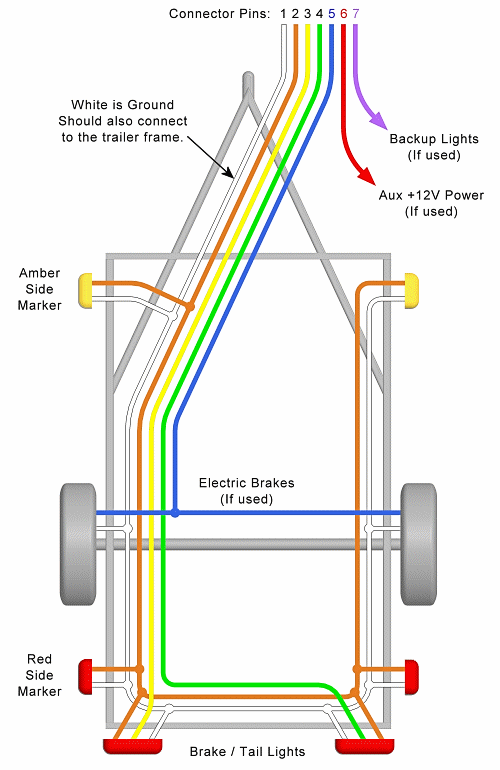
Single Axle Trailer Wiring

Tandem Axle Trailer Wiring
Typical Trailer Wiring Diagram and Schematic
The 2 above wire diagrams fit the needs of most trailers. The first image shows a single axle trailer, and the second, wiring for Tandem Axles. Only the (blue) brake and (white) ground wires are different. You can expand the same conditions for more axles.
Use only the needed wires, and ignore the others. For example, if you don’t need Auxiliary Power , just leave it out. If the axles do not have brakes, then no need for that. Don’t change pin numbers or wire positions if a function is not used — just leave the pin blank (not connected).
Three Center Marker Lights
The above trailer wire diagrams don’t show the triple set of marker lights central on the front and back. Some trailers need them, and some do not. Check local ordinances for requirements.

For trailers in the USA: Typically a red 3 light set is required on the back, if the trailer is 80″ or wider – or – if over 10,000 lbs GVWR. Also, near the top in the back if taller than a certain amount. An amber 3 light set is required near the top in the front, if taller than a certain amount (usually some amount over the height of the tow vehicle). Again, check regional requirements.
Typically the 3 center marker lights are at a high point on the trailer — like above the back doors for an enclosed cargo trailer. They are fine on the back bumper of a flatbed trailer, even when the load is much higher. There are lots of extras in the laws (like top corner markings), so find out what you need for your specific trailer.
If you need the more marker lights, connect them on the Brown and White wires just like the side marker lights. (See the partial trailer wiring diagram.) These do not require additional connections at the hitch, just more wiring within the trailer. These lights should be ‘on’ basically all the time.
Side Note: Reflectors
In addition to the three center marker lights, most trailers over 80″ width require reflectors or reflective tape in alternating red and white on the sides and back. There are a lot of regulations here for height, and GVWR, especially when trailers are longer than 20′. I’m not sure about requirements outside of the USA.
Check your local jurisdiction so you can mark and light your trailer properly. Reflectors and reflector types change by jurisdiction. To some, this is overkill, but even if it is, making it right can save you a ton of legal hassle and trouble.
Trailer Breakaway Wiring Diagram

If you have electric brakes (or electric over hydraulic or some others), then it will involve the trailer wiring. Here is a partial wiring diagram to include your trailer breakaway system. Since there is a lot to discuss, we have an entire article about breakaway kits with lots more information. In the meantime, use this diagram to guide the wiring of the system. Superimpose this on the images above to see how it all comes together.
The breakaway system usually resides in, on, or under the front part of the trailer. The pin pull switch is near the hitch. The system hooks into the electrical system by connecting Auxiliary Power (Red wire +12 VDC) to keep the battery charged, the Brakes (Blue wire) to actuate the brakes, and Ground (White wire) to complete the circuit. Again, please see the article about breakaway systems for a lot more information.
Wire Routing
Where do the wires go? Now that we have the trailer wiring diagram and some definition for connectors, where do the wires actually go?
Nestle the wires into and around the frame where practical for protection. We do recommend protecting the wires with a covering of some sort. The cover is not in the trailer wiring diagram, but flexible conduit, plastic conduit, or other approaches are great. A covering does not need to be watertight, but do consider weather protection when splicing into the wires. For tips on wiring, splicing, routing and protecting, see our post on trailer lights and wires . See more in the Wire Routing Notes below.
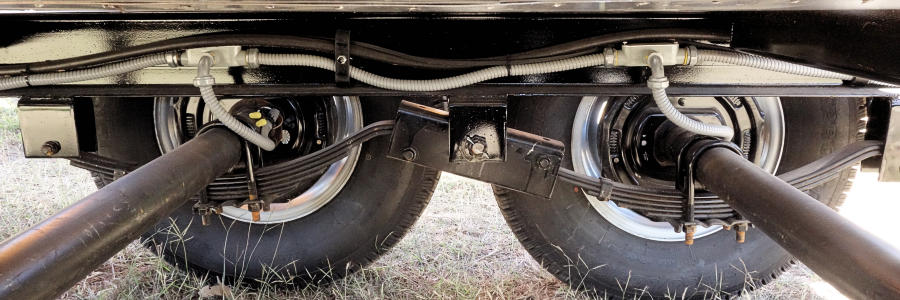
This photo shows an ideal way to handle trailer wires. While the flexible sealed conduit nestles in and secures to the frame, it protects the wires from snags and from weather. Great job on this one.
Trailer Wiring Diagram Notes
Many different sizes of wires are available. Typically wire sizes are list by “Gauge” — a smaller number is a thicker wire. We recommend 16 gage and larger for lighting. Then, for power hungry things like brakes, use a thicker wire size, like 14 gauge or 12 gauge. Same for Auxiliary Power.
Lighting circuits with low power lights like LED’s have low power requirements, so even with a lot of lights, they don’t use much power. For lights, a relatively small wire gage works. We still recommend 16 gage and larger, not so much because of the power requirements, but because the wires are stronger, more robust, and have more surface area for splice connections. It’s worth the small additional expense.
We recommend sealed and submersible LED lights for just about everything. Yeah, most trailers are never submersed, but almost all get very wet like in heavy rain or when washing. Pay the extra dollar or two and get the higher quality lights. Trouble free operation with higher quality lights make them worth it.
White Wire Notes:
The White Wire is the “Ground” or “Negative” wire connecting to the vehicle battery “minus” side. The trailer wiring diagram shows this wire going to all the lights and brakes. Also, it must connect with things (if included) that use the Aux Power and Back-up lights too.
Some trailer builders just connect this wire to the frame, then connect the ground from all the other lights and accessories to the frame as well. While this usually works, the ground portion of the circuit is often the root of trailer electrical problems. To avoid some of those issues we recommend running the white wire with all the others and connecting the ground from each light directly to the White. It is a little more work, but it can save big headaches later.
We also recommend connecting the white wire directly to the trailer frame (in addition).
Size: This wire should be at least as big as the largest wire in your harness. If only lights are in the circuit, and the lights are LED (low power), then a small white wire is acceptable. However, if you have electric brakes or auxiliary power, this wire must be larger.
Brown Wire Notes:
The Brown Wire goes to the lights that are always ON as you travel. These are the running lights, the low intensity portion of the tail lights, side markers, and corner markers. Also, if used, the sets of 3 lights central in front and back of the trailer. Check local laws for requirements on which lights your trailer needs.
While the typical sets of 3 lights central in the trailer are not in the above trailer wiring diagram, they are important in some situations. They are not normal for smallish DIY utility type trailers. However, if you need them or want them, the brown wire feeds them too (and the white for ground). Tiny Houses may or may not need the 3 lights, but again, check local laws.
Size: The Brown wire only feeds power to lights, so size it for the power requirements of your lights. For a utility trailer, that is probably not much power, so a smaller gage is OK. For a large enclosed trailer with lots of running lights, consider a larger gage.
Yellow and Green Wire Notes:
The two wires, Yellow and Green, handle double duty for function. They activate lights for both Turn Signals and for Brakes. It’s the same physical “light” at the rear of the trailer, but it serves 2 functions. The wiring in the vehicle sorts out how those signals are sent.
The Yellow wire handles the Left side – left as you look at the back of the trailer. (Or, in a different way of thinking, left as you are sitting in the driver’s seat of the tow vehicle.) The Green wire handles the Right side. See the above trailer wiring diagram for a visual.
Size: See the above discussion about Wire Size. We recommend 16 gage and larger for lights, and we recommend LED lights.
Blue Wire Notes:
Typically, the blue wire is for electric trailer brakes, however, this wire is not as standard as lights and ground.
For electric brakes, on the vehicle side the blue wire goes to the brake controller. Many styles of brake controllers are available, so find one that works for your vehicle. On the trailer side, the blue wire goes to the brakes and breakaway circuit. (See the trailer wiring & breakaway diagrams above.)
Here are some other ways the blue wire is sometimes used.
- Some trailers with surge hydraulic brakes use this 5th pin to disable the brakes when the vehicle is reversing. This is not in the trailer wiring diagram above. If you do this, then connect the blue wire to the reverse lights on the tow vehicle side, and be sure to note what you’ve done. Better yet, use a purple wire instead, and label it.
- Some places label the 5th pin for “Reverse Lights”. If you do that, then make sure to note it on the trailer, because it can cause a lot of trouble if connected wrong.
Just be careful when using a 5-pin connector. Make sure the car wires match functions of the trailer.
Compatibility Case Example: To solve issues with tow vehicle wiring that is different from my trailer (for instance when a friend wants to borrow it), I simply have a short adapter that connects the 5-pin harness to a 4-pin vehicle and the trailer goes without brakes. It works because the trailer is not big or heavy – and with a light load it does not require brakes. I just tell the borrower the load capacity is 3000# (even though true capacity is 5000#.) Another way is to have an adapter that goes from the trailer 5-pin to a standard 7-pin (with 2 wires left blank). That way the trailer brakes are ready, if the tow vehicle has a 7-pin connector.
Size: Don’t skimp on wire size for your brakes. For a single axle, 14 gage is good, but for tandem axles, use 12 gage wire.
Red Wire Notes:
The pin for Aux Power is usually with a Red Wire, but sometimes it’s different like Black. Sometimes we call it ‘Aux Power’ or ‘Auxiliary Power’ or ‘Accessory Power’ or ‘Batt 12V+’. Whatever the name it connects to the tow vehicle positive, DC power. Typically, auxiliary power is for charging the Breakaway battery, RV batteries, interior lights, power for accessories, etc.
The extent of routing for the Red wire is not on the above Trailer Wiring Diagram because it is optional, and different for every trailer. In the Breakaway wiring section, the schematic there shows how the Breakaway battery box connects to the Red. That maintains the battery charge.
If you don’t need separate power on the trailer, just leave that pin out. If you do use it, then be sure you protect the vehicle electric system from shorts (use a fuse or circuit breaker). Also, it’s good to protect the system from completely draining the tow vehicle battery.
Size: Use a wire size appropriate for the power demands. If it’s just for charging the breakaway battery, then 16 gage is fine. If you’re powering up more batteries or lights in the trailer, then use 14 or even 12 gage. Don’t overload this wire. If you do need large amounts of auxiliary power, use a generator or install special wiring from the vehicle alternator.
Wire Routing Notes:
The trailer wiring diagram above gives one flavor for routing direction – starting at the tongue connector, then wrapping around the trailer. Other people suggest splitting the wires near the tongue, then routing down both sides — Right and Left specific. Either approach is fine.
While wire routing is a personal preference, I like the wrap around approach a little more because it makes a ‘trunk’ that distributes power as it goes. It also keeps the wires all in one group as they traverse along the tongue so they are easier to protect. The amount of wire is almost identical for both the split and wrap around approach.
Protecting The Wires:
Hollow frame members are often the route for wires. For instance, if the frame is constructed of rectangular steel tube , then putting wires down the tube seems like an easy way to protect them. While this is true, it also means that you can’t cap (seal) the ends of the tube to keep moisture out. That’s a trade-off to consider, but it does not have to be all or nothing. On my last trailer, I routed the wires through the tongue tube, then outside the main frame members (tubes) so they can seal. Wire and light connections are outside of the frame tubes under the trailer bed.
When running wires consider the possibility of changes down the road. If you’re sure changes will never happen, button things up super tight. If you think changes might happen later, then leave access to the wires. For example, for a little camper, you might think Aux Power is on the “I’m never going to use that” list. But in a few years, you might find the solar doesn’t always cut it, and Aux Power is suddenly desirable. By leaving access to the wire routing, running the additional wire is not so difficult. Food for thought.
JavaScript seems to be disabled in your browser. For the best experience on our site, be sure to turn on Javascript in your browser.
- My Purchase Orders
- Compare Products

- Understanding Towing
- Trailer Wiring Diagram and Installation Help - Chapter 7
Trailer Wiring Diagram and Installation Help
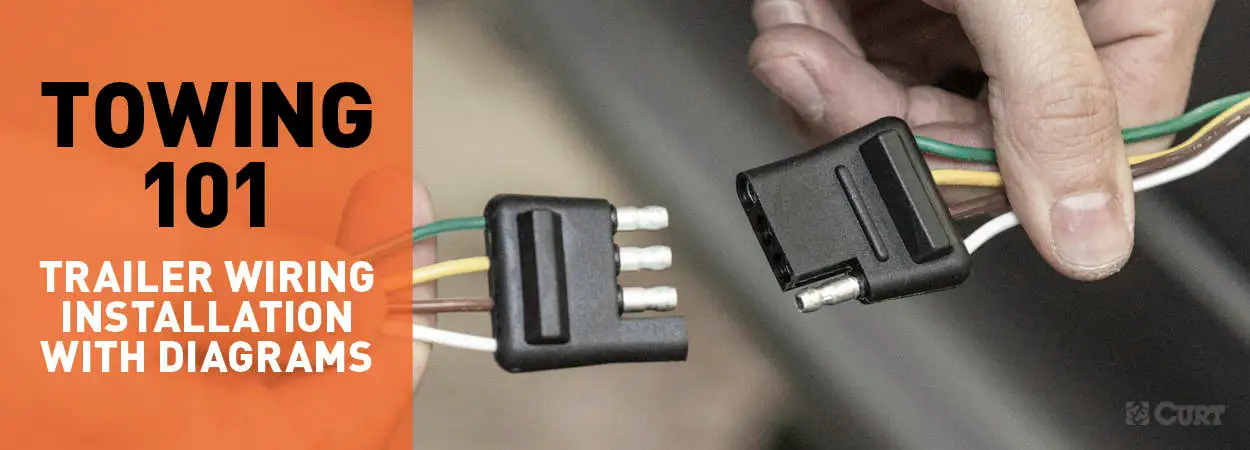
Equipping Your Vehicle with Proper Trailer Wiring
Any vehicle towing a trailer requires a trailer wiring harness to safely connect the taillights, turn signals, brake lights and other necessary electrical systems.
If your vehicle is not equipped with working trailer wiring, there are a number of different solutions to provide the perfect fit for your specific vehicle. Complete with a color coded trailer wiring diagram of each plug type , this guide walks through each available solution, including custom wiring, splice-in wiring and replacement wiring.
If you're looking to replace the wiring on your trailer, check out our trailer rewiring guide .
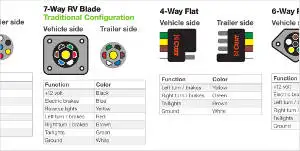
3 Options for Installing Trailer Wiring on Your Vehicle
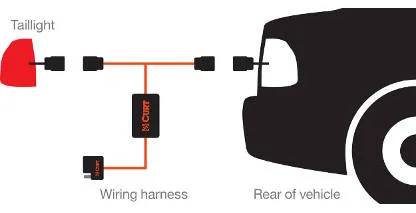
A. Custom wiring
Vehicle-specific plug-and-play harness that requires no splicing and provides a standard trailer connector
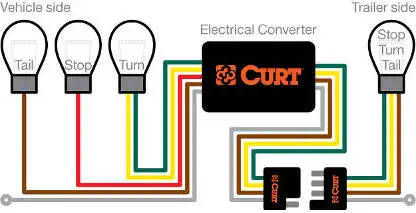
B. Splice-in wiring
Taillight converter that splices into your existing vehicle wiring and provides a standard trailer connector
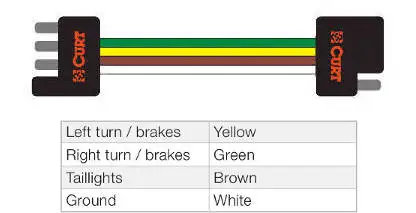
C. Replacement plugs and sockets
Trailer plugs and vehicle sockets to splice in and replace damaged wiring connectors
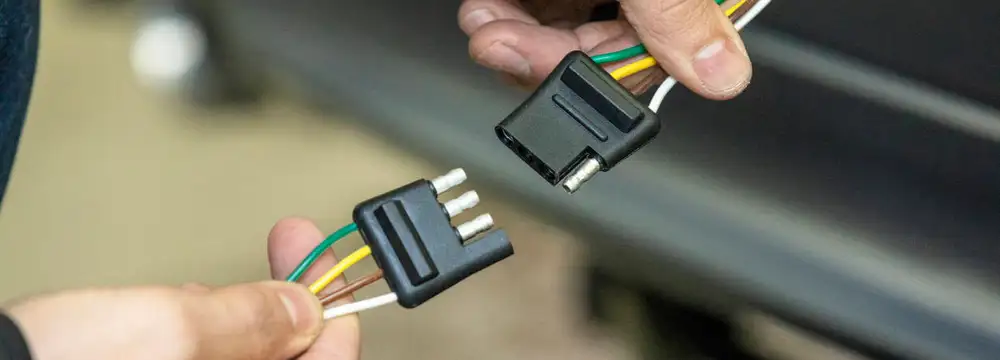
Option A: Custom Wiring Installation
Custom wiring is the ideal solution for installing trailer light wiring on your vehicle. A custom wiring harness or 'T-connector' is a vehicle-specific harness that plugs in without any spicing required and provides a standard connector output, such as a 4-way flat.
All CURT custom wiring comes with the exact components needed for a complete installation on the vehicle, including vehicle-specific plugs and an electrical converter, if needed.
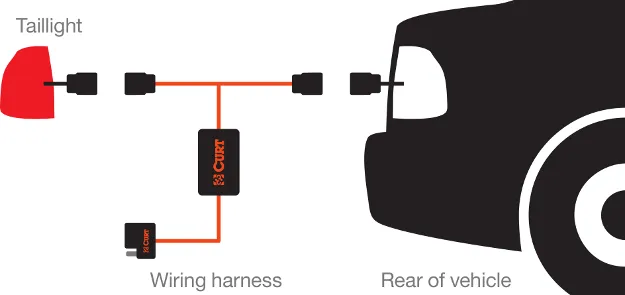
Custom Wiring Harness Installation Example Video
Two Types of Custom Wiring

Custom Wiring Harnesses
A custom wiring harness has multiple plugs that are used to 'T' into the vehicle's taillight assembly, drawing power directly from the taillights or from a direct battery connection and providing a standard trailer light wiring connector. While custom wiring harnesses usually require two or more connection points, splicing and soldering are still not needed.

Custom Wiring Connectors
While some vehicles may not be equipped with a standard trailer wiring connector, they may have a special socket specifically intended for installing wiring, provided by the vehicle manufacturer. A custom wiring connector uses a single plug to plug into this factory socket and provide a standard trailer wiring connector.

Original Equipment Trailer Wiring for USCAR
Another type of custom wiring is original-equipment (OE) wiring or USCAR wiring. Select vehicles come with a standardized USCAR socket that provides a connection point for a CURT OE wiring harness.
Like a T-connector, an original equipment wiring harness plugs into the USCAR socket without any cutting, splicing or soldering required, and it provides a standard trailer wiring output, such as a 4-way flat or 7-way RV blade.
Learn more about USCAR wiring
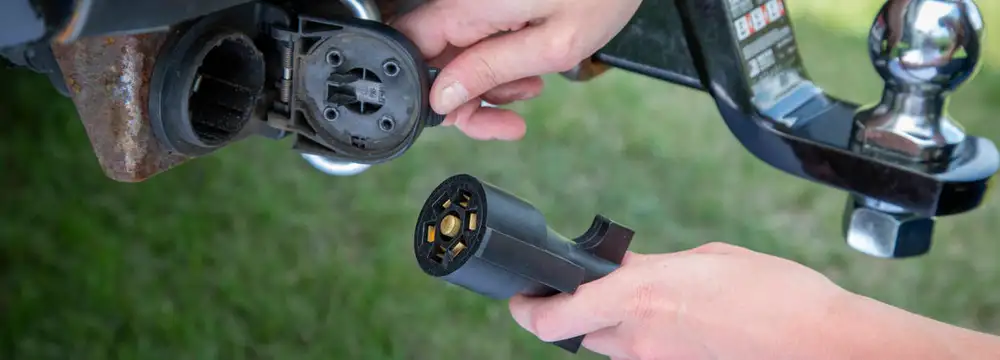
Option B: Taillight Converter Splice-in Wiring
If custom wiring is not available for your particular make and model, a taillight converter may be required to equip your vehicle with the proper trailer light wiring connection.
A taillight converter or electrical converter splices into your vehicle and provides a standard trailer plug wiring connector, typically a 4-way flat. The converter converts the vehicle's complex wiring system to be compatible with your trailer's simple wiring system. To learn more about vehicle wiring systems, check out our vehicle wiring systems guide .
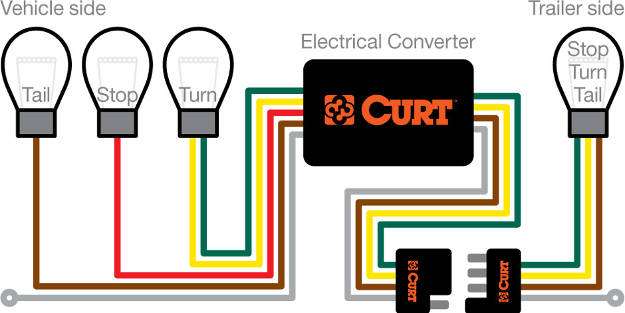
Splice-In Wiring Installation Example Video
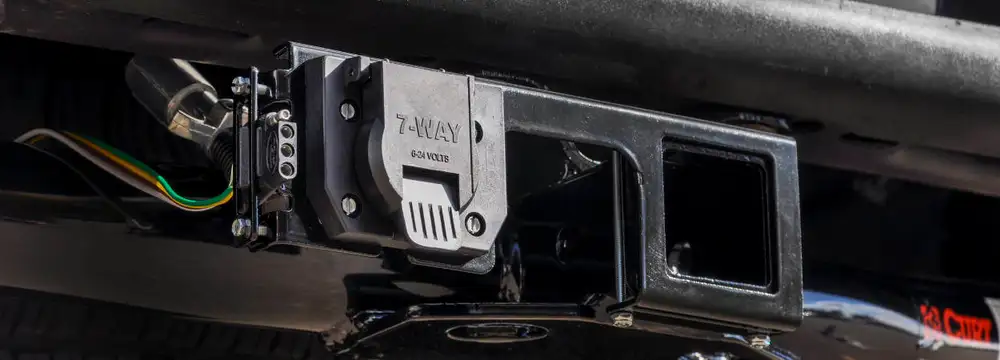
Option C: Replacement Vehicle and Trailer Plug Wiring
If the trailer plug wiring on your vehicle or trailer is damaged or not working correctly, you can replace the connector with a CURT splice-in plug or socket.
Plugs (trailer side) and sockets (vehicle side) are available in all standard formats and can be spliced into your existing trailer plug wiring. Find the trailer light wiring diagram below that corresponds to your existing configuration.
If you are rewiring your trailer completely, check out our trailer rewiring guide .
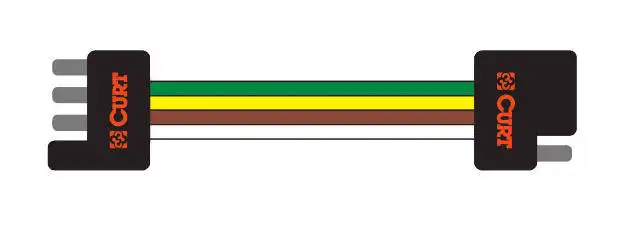
How to Wire Trailer Lights
4-pin trailer pwiring diagram.
Following the standard method for wiring a trailer connector is vital to the safety of your vehicle while towing. Connecting the wrong color wires will result in mismatched taillight functions and confusion on the road.
Use this 4-pin wiring diagram to properly wire your 4-wire trailer plug.
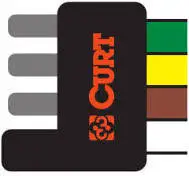
• Green Right turn / brakes • Yellow Left turn / brakes • Brown Taillights º White Ground
4-Wire Trailer
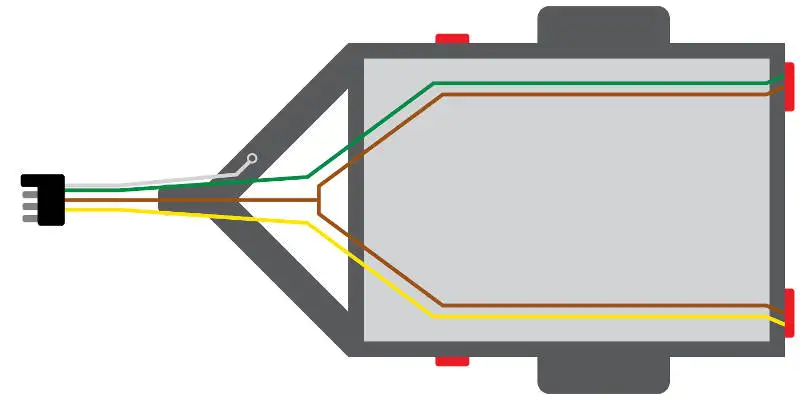
Note: The ground wire color for a 4-flat plug is white and should be properly grounded at the trailer tongue. Read the complete rewiring guide for more.
5-Pin Trailer Wiring Diagram
5-pin trailer wiring is very similar to 4-pin wiring, but it adds in a blue wire for the reverse or backup lights.
Not all trailers have reverse lights, so consider your own trailer as you wire in a 5-way plug.
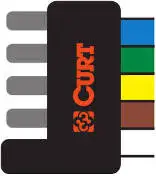
• Blue Reverse lights • Green Right turn / brakes • Yellow Left turn / brakes • Brown Taillights º White Ground
5-Wire Trailer
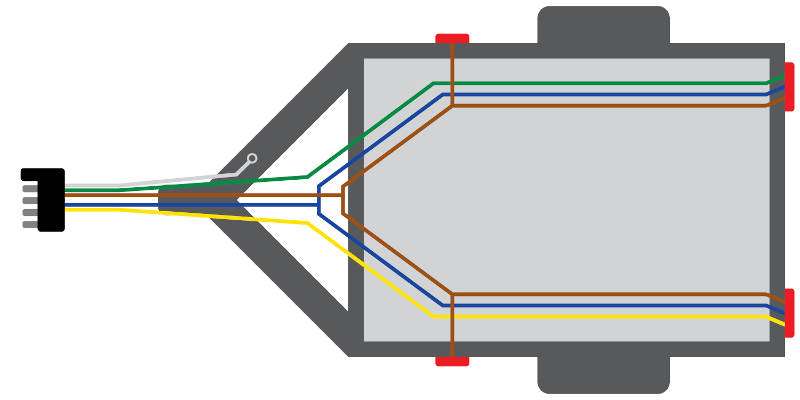
6-Pin Trailer Wiring Diagram
6-pin trailer wiring introduces two new functions, a wire for connecting trailer brakes and a wire for +12-volt auxiliary power.
6-way wiring is most common on gooseneck trailers and allows for use with a brake controller.

• Brown Taillights • Blue Electric brakes • Green Right turn / brakes • Yellow Left turn / brakes º White Ground • Black +12 volt
6-Wire Trailer
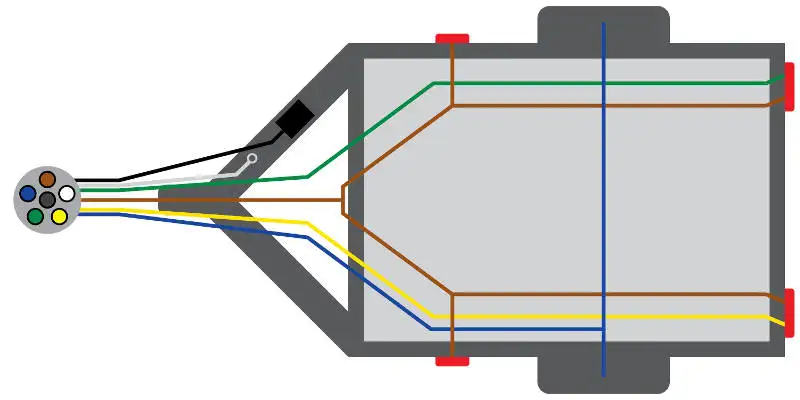
Round 7-Pin Wiring Diagram
The 7-way round trailer plug is to be distinguished from 7-way RV blade plugs. The wiring connections and placement are different.
Be sure to review your own trailer connector before wiring.

º White Ground • Brown Taillights • Green Right turn / brakes • Red Auxiliary power • Yellow Left turn / brakes • Black Reverse lights • Blue Electric brakes
7-Wire Trailer (Round Prongs)
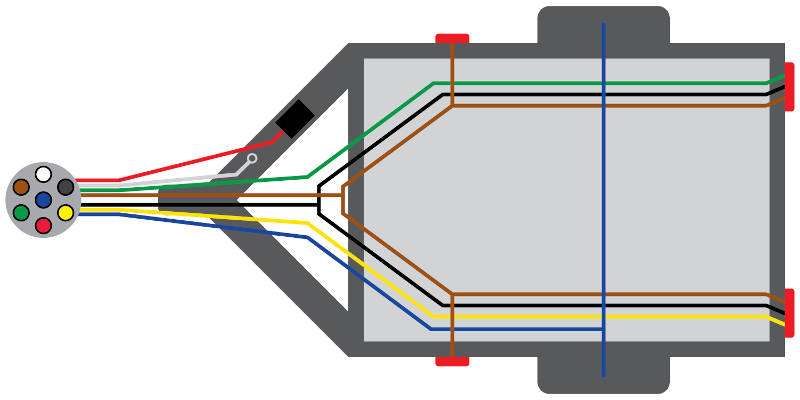
RV Blade 7-Pin Trailer Wiring Diagram - SAE
The SAE configuration of a 7-way RV blade plug should not be confused with the traditional configuration. Different wire colors are used for different functions.
Review your own trailer before wiring.
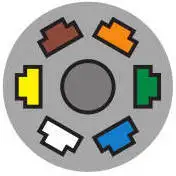
• Brown Taillights • Yellow Left turn / brakes º White Ground • Blue Electric brakes • Green Right turn / brakes • Orange +12 volt • Grey Reverse lights
7-Wire Trailer (RV Blade - SAE)
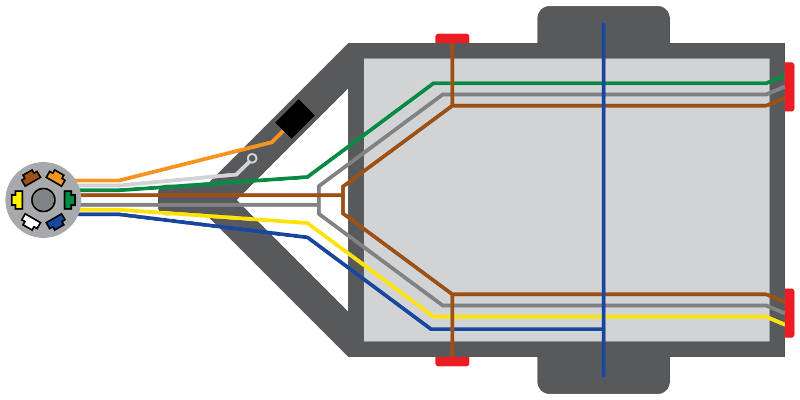
RV Blade 7-Pin Trailer Wiring Diagram - Traditional
7-pin trailer wiring is one of the most popular wiring configruations, particularly the traditional configuration versus the SAE J2863.
Use this 7-pin trailer wiring diagram to properly wire your 7-pin trailer plug.
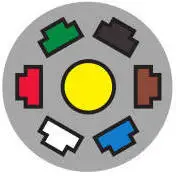
• Green Taillights • Red Left turn / brakes º White Ground • Blue Electric brakes • Brown Right turn / brakes • Black +12 volt • Yellow Reverse lights
7-Wire Trailer (RV Blade - Traditional)

Note: Not all trailers are equipped with reverse lights (yellow wire). The position of this wire may vary for your own specific setup.
Trailer Plug Wiring Colors & Diagrams
Note: The ground wire color on all trailer plug types is always white. Other colors vary in function, depending on the configuration.
Download complete table
7-Way RV Blade - Traditional Configuration
7-way rv blade - sae j2863 configuration, differences in 7-pin trailer wiring, traditional configuration.
The traditional 7-way RV blade format is typically used on 5th wheel trailers, travel trailers and campers. The trailer wiring colors for this configuration are different than those on the SAE configuration.
SAE J2863 configuration
The SAE J2863 7-way RV blade format is typically used on gooseneck trailers, utility trailers, cargo trailers and equipment trailers.
7-Way Round
6-way round.

6-Way Square
º White Ground • Red +12 volts • Blue Electric brakes • Yellow Left turn / brakes • Brown Taillights • Green Right turn / brakes
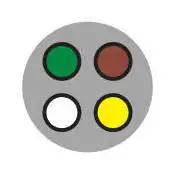
4-Way Round
• Green Right turn / brakes º White Ground • Yellow Left turn / brakes • Brown Taillights
Common Connectors by Trailer Type
Trailers are equipped with different plug types based on their electrical components. The chart below provides examples of common trailers and the types of plugs they typically use.
Towing 101 Table of Contents
Looking for more.
Discover more great tips and how-tos on the Lippert blog -- your destination for all things RVing, towing, boating and beyond!

Products See all products
Trailer Wire Colors Guide: Colors and Functions
- November 28, 2023
Vehicles (RVs) have been a popular choice for many years due to their versatility and convenience. So there will be more people’s who will have the question, how do I wiring a trailer wire ?
We are knowledgeable in this area and will explain the different types of wiring systems for trailers, from 4-pin connectors to more complicated 7-pin systems. We will also explain the meaning of each trailer wire colors in detail.
Understanding the Basics Trailer Wiring System
Before we dive into the trailer wire color codes, let’s begin with the basics of trailer wiring systems. As an important part of your trailer, the main purpose of trailer wiring harnesses is to provide a vital electrical connection between the towing vehicle and the trailer so that they can operate as an integrated unit for lighting, braking, and other functions.
The trailer wiring system consists of wires, connectors, and plugs. Connector on the tow vehicle is called the “female connector” and the wiring harness connector on the RV or trailer is called the “male connector”. Trailer wiring types are primarily differentiated by the number of pins or contacts they have; common ones include 4 pin trailer wiring, 5 wire trailer wiring, 6 pin trailer wiring, and 7 pin wiring to accommodate different trailer types. (European 13 pin trailer wiring is also available).
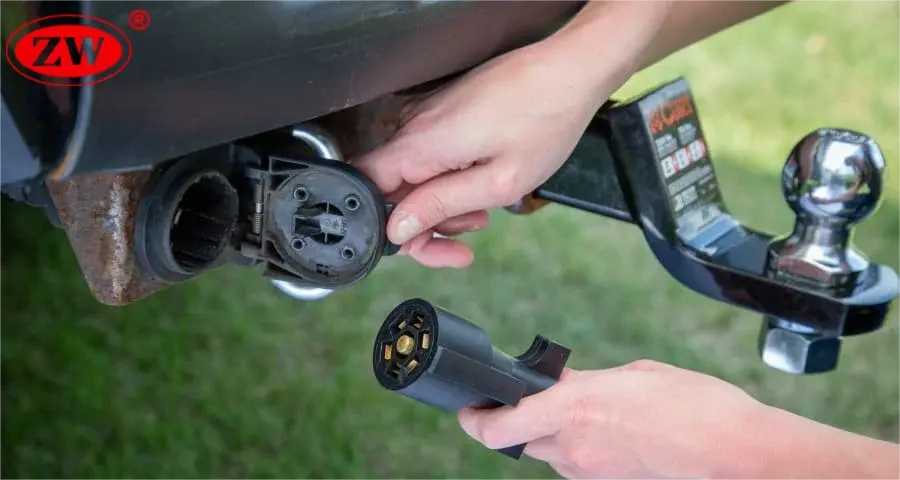
While the color of trailer wire may vary slightly, there are accepted color codes to keep trailer wiring systems consistent. Next, let’s take a look at the most common trailer wire colors and their respective functions.
Decoding Standard Trailer Wire Colors
Trailer wiring usually contains seven standard colors, which are analyzed as follows:
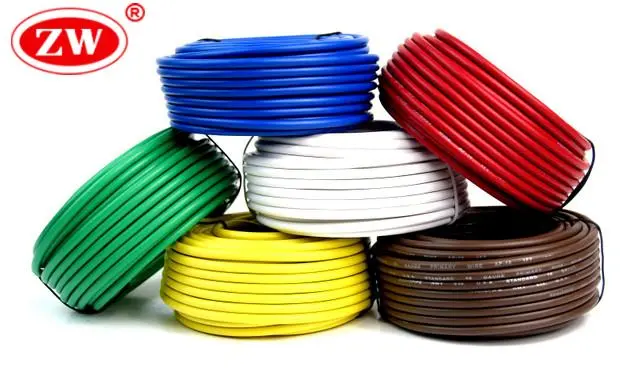
- White trailer w ire : The ground wire that provides a grounding return path by connecting the battery’s negative terminal to the trailer’s frame, thereby enabling the flow of the current back to the battery. The grounding capability is a prerequisite for all other electrical systems in the trailer, including the lighting and braking systems to operate effectively. Therefore, the properly connected white ground wire actually helps keep drivers safe on the road( should be the first one to be connected).
As far as the wire size is concerned, the white ground wire should be the thickest, or as thick as the thickest wire in the system to ensure that the ground wire can handle the total current of all grounding systems. Otherwise, it may not effectively return current, leading to potential electrical problems or even safety hazards.
- Brown trailer w ire : supplies power to a trailer’s running lights, taillights, and corner markers. These lights play a vital role in vehicle visibility and safety in low light or nighttime driving conditions. For example, even if a towing vehicle’s headlights are turned off, the running lights powered by brown wire will remain on to illuminate the trailer’s outline, helping other drivers aware of the presence and size of the trailer(small trailers don’t necessarily need all three lights).
The thickness of the brown electrical wire depends on the size of the trailer and the power needs of the lights. If the trailer is big or has many high-powered lights, it needs a thicker brown wire to provide enough power for all the lights. A smaller trailer with fewer or less powerful lights can use a thinner brown wire. Additionally, LED lights use less power than regular halogen lamps, allowing the use of thinner brown wire.
- Yellow trailer wire: lights up the left turn signal and brake light on the trailer when the same lights are turned on in the towing vehicle.
- Green trailer wire: lights up the right turn signal and brake light on the trailer when the same lights are turned on in the towing vehicle.
- Blue trailer w ire : trailer brake wiring. When connected to electric brakes, the blue wire sends the towing vehicle’s brake pedal input to the trailer’s braking system, which synchronizes the trailer’s braking with that of the towing vehicle, thereby increasing safety and control. Given that braking is a critical safety function for any vehicle, the blue wire needs to be robust and thick enough.
- Black or red trailer w ire : Auxiliary power or battery 12V+. The black (or sometimes red) trailer wire is responsible for providing a 12-volt power supply from the towing vehicle’s battery to the trailer’s onboard systems, such as interior lights, refrigerator, or other appliances that need power when the trailer is not hooked up to external power. This auxiliary power wire plays a critical role in ensuring that the trailer’s amenities can function independently without an external power hook-up, thus making the trailer more flexible and self-sufficient during traveling use.
Trailer wiring systems use different colored wires to perform specific functions, and there could be other trailer wire colors in addition to those listed above. All trailers require basic elements like lighting and grounding; however, whether other wires are included depends on the specific function of the trailer. Next, we’ll enter into trailer wiring diagrams.
Trailer Wiring Diagram (4-Pin, 5-Pin, 6-Pin, 7-Pin)
As we mentioned above, different wiring systems contain different amounts of wire and thus support different functions. Well, in this part we will specifically analyze the different trailer wiring types and provide trailer wiring diagrams and outlet wiring guides. First up are the various connector pin codes or plug wiring diagrams:
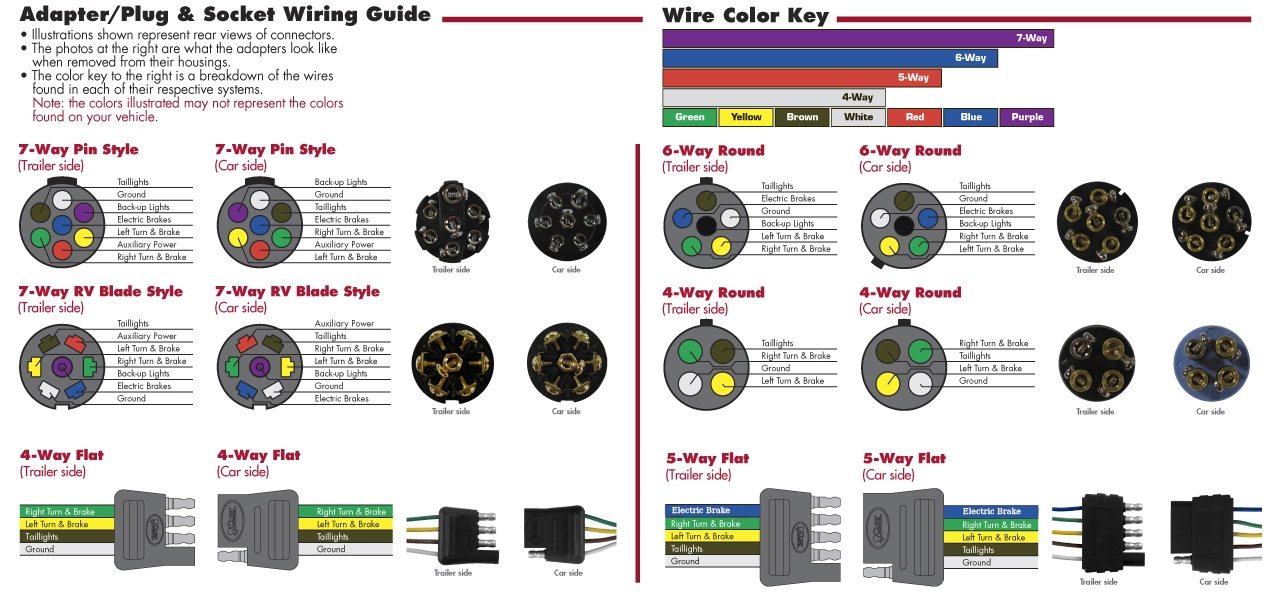
Based on the above pin arrangement, you will know how to mate the male and female plugs together. Simply use the pin arrangement as a guide and pair the wires according to their function. The male and female plugs are designed to be symmetrical, so make sure the wires are correctly aligned for color and function.
Next is the specific wiring diagram for trailer lights.
4 way trailer wire diagram :
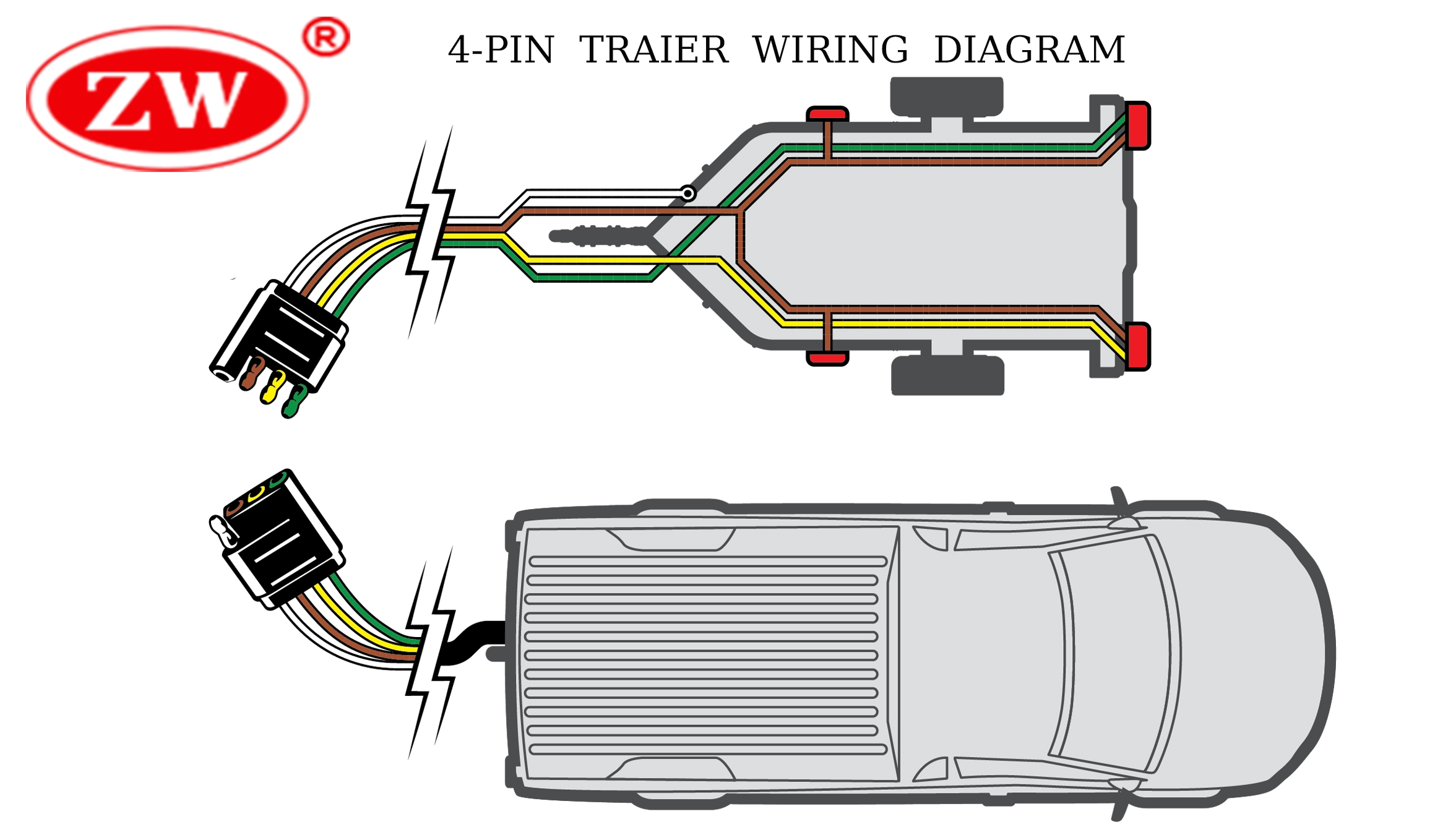
4-way connector ( Normally Flat or Round): the most basic wiring configuration covers the basic lighting functions and is commonly used for small and lightweight trailers.
- White: Ground
- Brown: Tail/Running Lights
- Yellow: Left Turn Signal/Left Brake Light
- Green: Right Turn Signal/Right Brake Light
5 wire trailer wiring diagram :
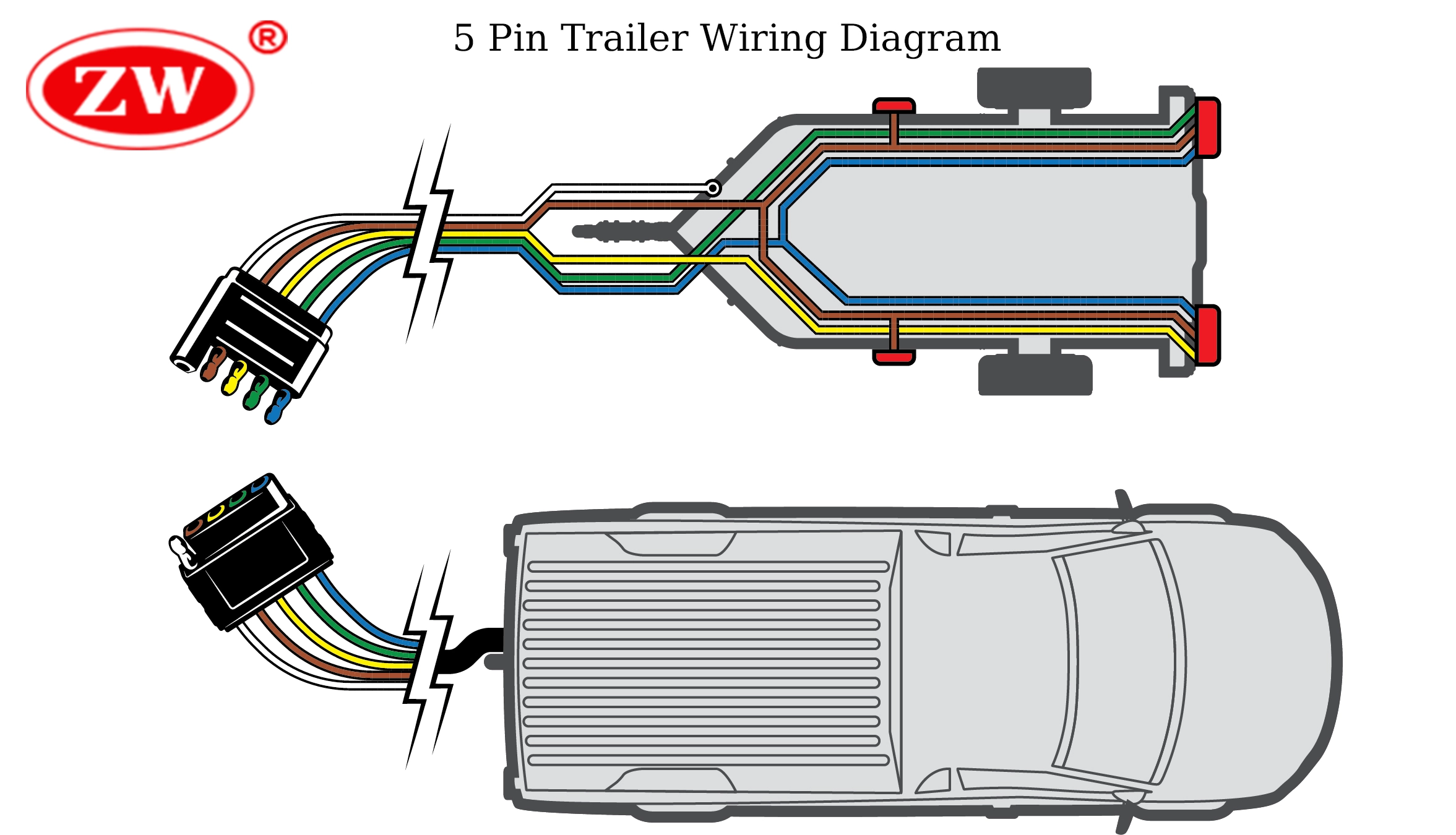
5-way plug adds an additional blue brake wire to the 4-pin setup. This configuration is typically used on heavier trailers equipped with electric brakes to prevent rollover accidents while reversing.
- White : Ground
- Brown : Tail/Running Lights
- Yellow : Left Turn Signal/Left Brake Light
- Green : Right Turn Signal/Right Brake Light
- Blue : Electric brakes
6 pin trailer wiring diagram :
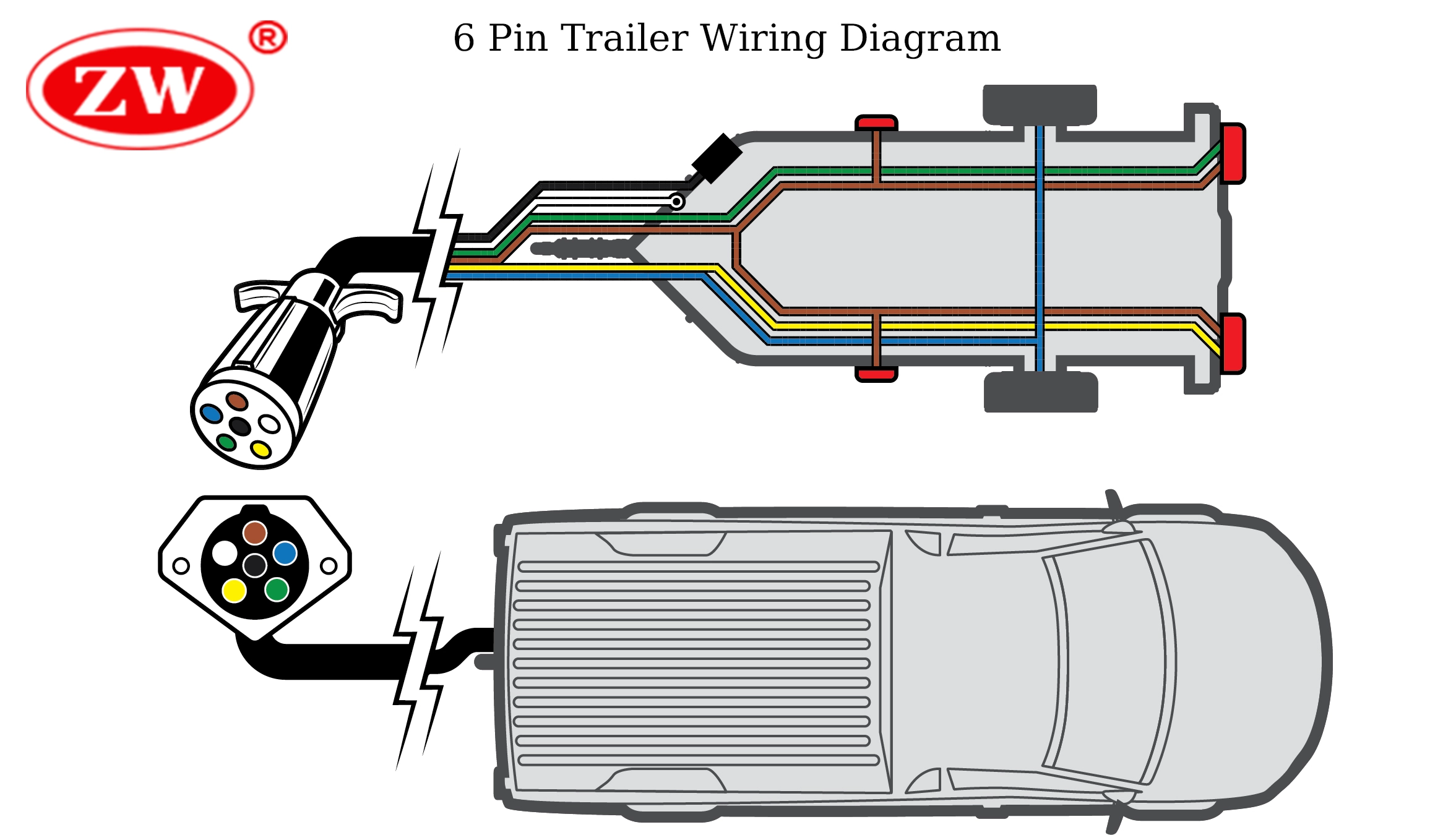
6-way plug (Normally Round) is more common on larger trailers like gooseneck trailers or those with additional power requirements. 6-way wiring adds a black wire to the five-way configuration for auxiliary power or charging the trailer’s battery while being towed.
- Black : Battery + 12v
- Blue: Electric Brakes
7 way trailer plug wiring diagram (SAE Standard):
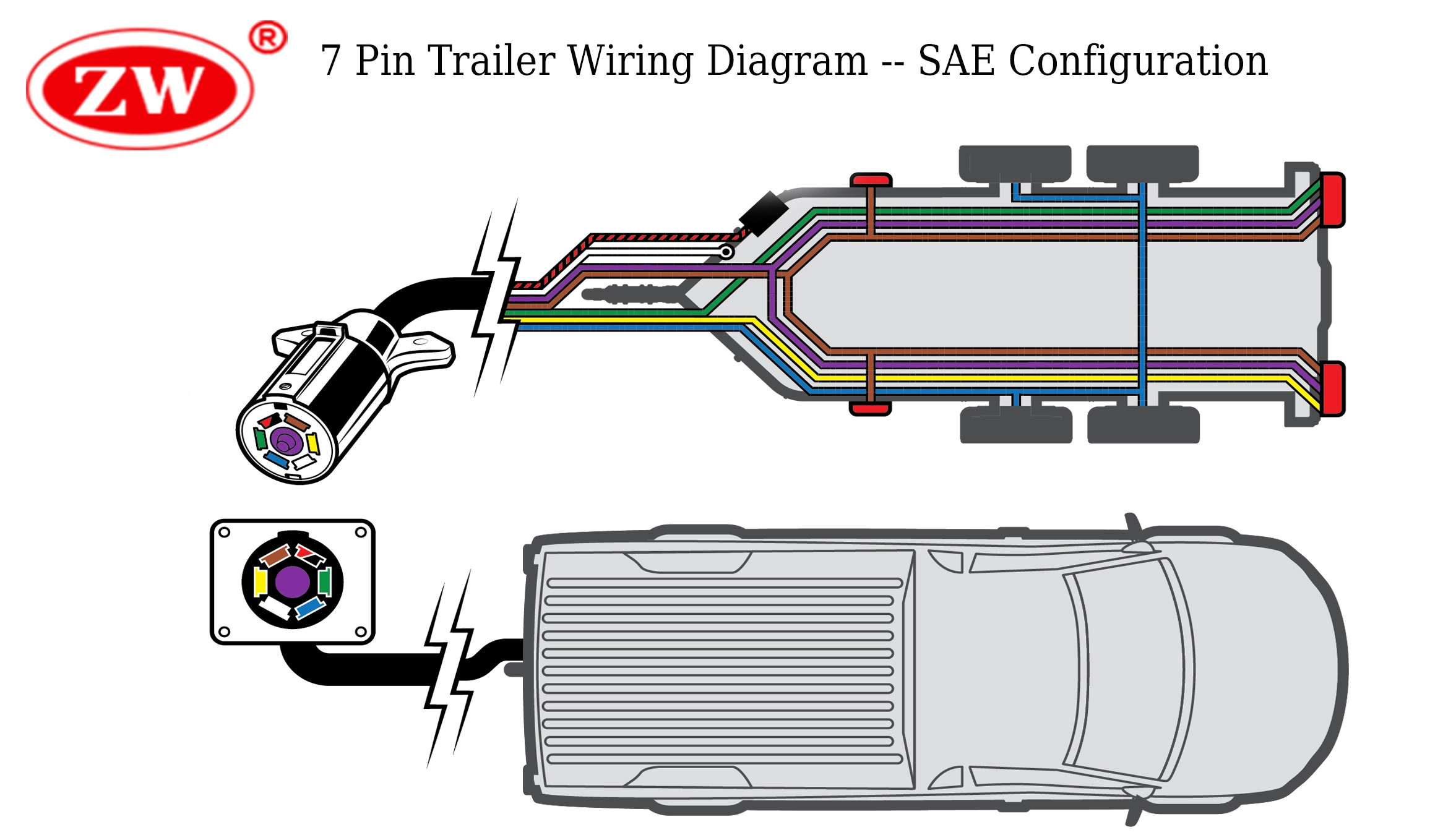
7 way trailer wiring is the most comprehensive configuration and is often used for large trailers (7 blade trailer plug is the most commonly used ). Standard 7 pin trailer wiring includes all the wires mentioned in the previous configurations, providing additional connections for electric brakes, auxiliary power, and a backup light or auxiliary function. The additional trailer wire color may be differed by requirement details. 7 blade trailer plug wiring (SAE standard) is typically used for commercial trailers, like cargo trailers and equipment trailers.
- Purple: Reverse Lights
- Blue : Electric Brakes
- Black or Red : Battery +12 volt
- Green : Right turn/brakes
- Yellow : Left turn/brakes
There is also traditional RV standard 7 blade trailer wiring, however, they changed a lot from the previous.
Color Coding for 7-way RV Standard Lights Wiring :
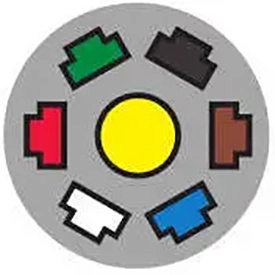
- Green : Tail/running lights
- Red : Left turn/brakes
- Brown : Right turn/brakes
- Black : Battery +12 volt
- Yellow : Reverse lights
RV standard plug wiring is commonly used on travel trailers and campers in North America (so you can call it 7-pin trailer plug wiring diagram usa). If your trailer light wiring appears disorganized and you really don’t know which trailer wire does what, using a circuit tester pen for identification would be a wise approach.
Trailer wire connectors can generally be adapted or converted to each other with specific adapter devices. For example, if your trailer utilizes a 4-pin connector and your vehicle is equipped with a 7-pin socket, you can use a 4-pin to 7-pin adapter to facilitate the connection. However, adapters can’t add or expand capabilities. That is, even if you change the 4-pin connection to 7-pin connection, you can only utilize the basic lighting circuits and can’t access the other functions allowed by the 7-pin connector. To enable the full functionality, you should upgrade the trailer harness to actually contain the required wiring and circuits. With trailer wire colors and wiring out of the way, let’s take a look at the sizes.
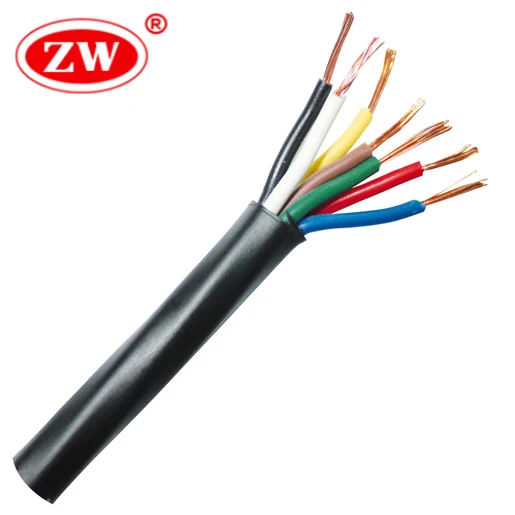
Trailer wire is a type of electrical wire designed to connect the electrical system of a trailer to that of a towing vehicle, thus ensuring the proper operation of both vehicles. Typically, trailer wires consist of stranded copper wires that are each wrapped in a unique color of PVC insulation, with a PVC sheath serving as …
Choose the Right Trailer Wire Gauge
Standard trailer wire gauges usually range from 18 to 12, with 12 gauge being the thickest. Trailer size, power, the number of functions, and the loads the trailer will carry can all affect trailer wire gauge; larger trailers with heavier loads should opt for heavy-duty trailer cable for reliability and safety, like 14 gauge or 12 gauge. For a typically 7-way trailer wire connector, it is recommended that 12-gauge wire be used for the ground wire, battery hot lead wire, and brake wire, with 16-gauge being the minimum recommended standard for the remaining connections. Below is a trailer wire size chart:
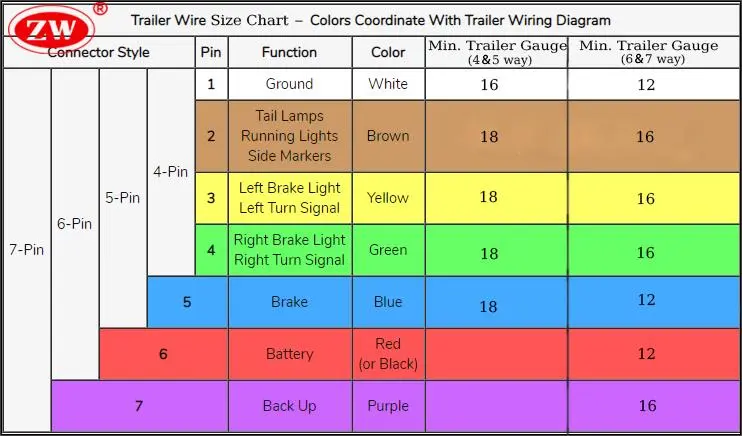
The selection of wire gauge for trailer wiring is subjective to the specific requirements and isn’t strictly dependent on the size of the trailer. While larger trailers often require thicker (lower-gauge) wires to accommodate more electrical components and heavier loads, there can be scenarios where smaller trailers may also need larger wire sizes (e.g. with high power-demanding features or components away from power sources ). In this case, it’s wise to consult a professional manufacturer such as ZW Cable.
Pro Tips for Wiring Your Trailer
- Avoid using buck joints and tees: Buck connectors and tee-offs, while convenient, tend to be problematic as they can accumulate moisture and corrode over time. Instead, consider using 7-way junction boxes with protected wire loom for more reliable operation.
- Cable Routing and Protection: Keep wires away from sharp edges, moving parts, and heat sources. If necessary, use wire looms or cable ties to secure them well to prevent vibration-related damage.
- Ground Your Trailer Properly: A common issue with trailer wiring is a poor ground connection; make sure the ground wire is securely connected to a clean, bare metal surface on the trailer frame for effective ground.
- Invest in high-quality grommets and wires: Good-quality grommets protect your wires from the sharp edges of the holes they pass through, while high-quality wires are more durable and ensure reliable connections. Investing in quality components upfront can save you from headaches and repair costs later on.
- Use Heat Shrink Connectors: Opt for heat shrink connectors when splicing wires. Not only do they provide a strong connection, but when heated they form a watertight seal that helps prevent corrosion.
- Keep Spare Fuses: Always carry spare fuses with you. A blown fuse can cause trailer lights or other electrical systems to stop working.
- Regular Maintenance: Regularly inspecting the wiring system and addressing issues immediately is essential. Waiting for a part of the wiring system to break before replacing it can lead to more significant problems and potential safety hazards.
- Be Patient: Wiring trailer lights can be a complex task, especially for beginners. Take your time, double-check everything, and don’t rush the process.
All in all, understanding trailer wire colors, functions, and the appropriate wire gauge is more than technical know-how; it’s fundamentally about ensuring your safety and optimizing the performance of your RV for each journey. Whether it’s powering the brake lights, running lights, or electric brakes, each wire plays a critical role in the overall functioning of your trailer’s system. And the pin and wire coding also makes installation and troubleshooting easier.
Though we provide a comprehensive overview of standard trailer wire colors and gauges, it’s worth noting that variations may exist due to factors such as the manufacturer’s standards, the trailer’s size, and the specific electrical needs of your trailer. Whether you’re wondering how to wire trailer lights or have questions about choosing sizes, ZW Cable is the trailer manufacturer you can trust and has all covered.
Related Post:
1. Understanding Electrical Cable Colours: Codes And Roles

My name is Richard Zi, and serve as the General Manager of ZW Cable. With a deep and extensive background of more than 15 years in the cable industry, I am excited to share my wealth of knowledge and experience.ZW Cable is a renowned company in the field of cable manufacturing in world, we specialize in selecting the best cable sizes and effectively solving all your cable challenges. If you have any questions or needs regarding cable solutions, please contact me and I assure you of the highest standards of personalized and effective guidance and support. View All My Posts >>
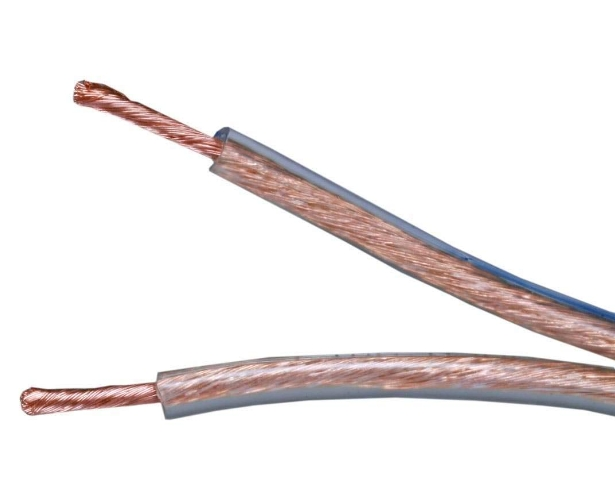
It has always been the case that the use of high fidelity home audio systems is not possible without the operation of each component. And
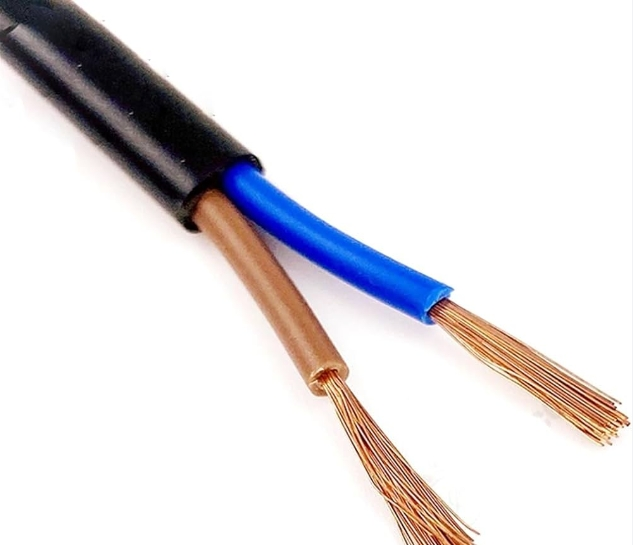
If you are planning to lay cables that will last for a long time, then you will need double insulated wire. In some cases ordinary
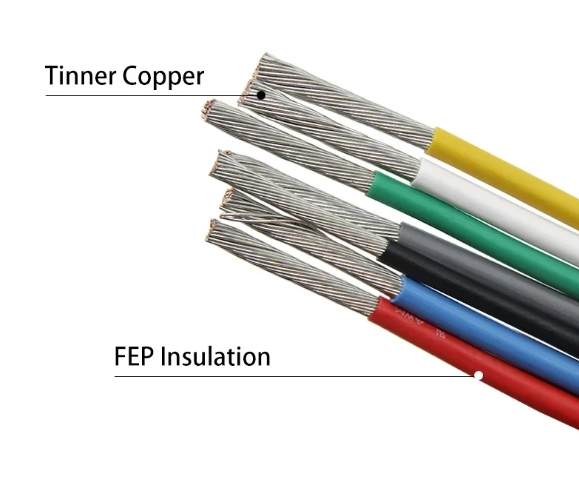
Regardless of the environment in which the cables are used, the stability and safety of the circuits has always been a topic of emphasis. Fluorinated
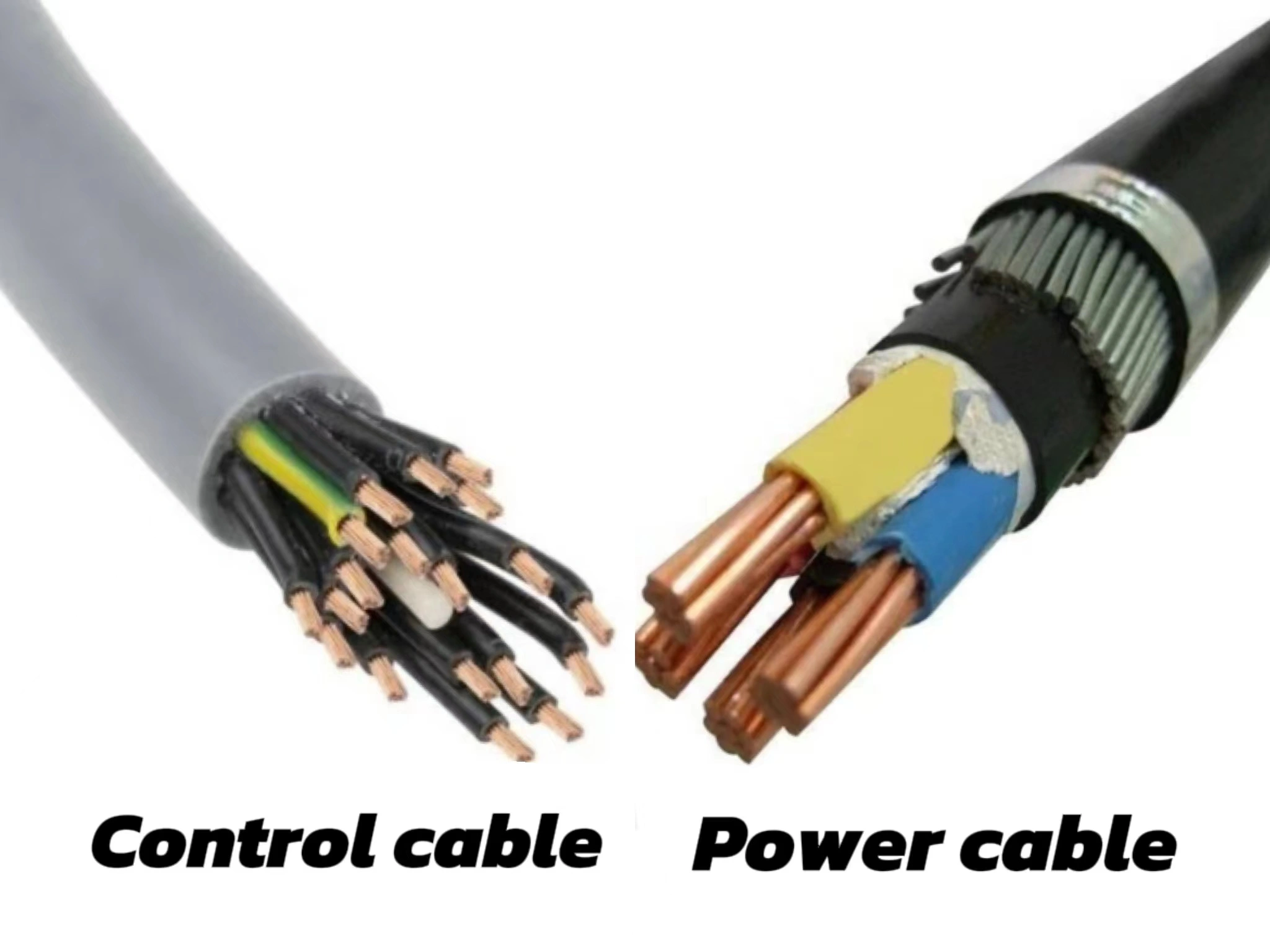
We may often hear about power and control cables in electrical engineering projects. Power cables vs control cables are both important types of cables used
- E-mail: [email protected]
- + 86-13683822973
- [email protected]
- +86-13683822973

Contact Form
Trailer Wiring Diagram and Color Chart
How to install new wiring or repair a bad connection
- Cars & Motorcycles
- Frugal Living
- Fine Arts & Crafts
- Card Games & Gambling
- Playing Music
Whether you're installing a new trailer light circuit in your car or truck or trying to troubleshoot trailer wiring that is not working, you'll need to understand what each wire in the trailer wiring harness does, where it likely goes, and why it may not be working well. This diagram shows the colors of a basic trailer wiring setup as well as what each wire is supposed to be connected to.

A Simple Closed System
While it's never a good idea to dive into a wiring project blind, trailer wiring is actually very simple to work on and troubleshoot . For the most part, the wiring harness that operates your trailer lights is a closed system. The only point of contact to the outside world (meaning the world that exists outside of the trailer itself) comes on the truck side of the four-prong connector (or seven-prong connector if you are using a higher end system for trailers with electric braking systems ). Even on the truck side, where the trailer wiring intersects with your vehicle's wiring harness, there are only four wires to deal with. When you're troubleshooting the trailer wires, be sure you do it one wire at a time, starting by checking your ground wire with a circuit tester .
Trailer Wiring Colors
The worst that usually happens with screwy trailer wiring is a blown fuse on the tow vehicle—or something wacky, like reversed turn signals or blinking brake lights. While none of these are things we look forward to when pulling a trailer, they are also easy to correct. These four colored wires make up your trailer's wiring system. Each connects to a different function:
- Brown wire to the tail or parking lights
- Green wire to right turn signal/brake light
- Yellow wire to the left turn signal/brake light
- White wire to common or chassis ground
When making your repairs or hooking up your trailer, you simply make sure these wires are running to the appropriate component as shown above.
Lights On, Always
Never put your trailer on the road with questionable wiring or a lighting system that is already known to be failing. As drivers slow down behind a vehicle that is pulling a trailer, they will often instinctively focus on the bright brake lights as a reference point for where to stop and how quickly the vehicle in front is stopping. If you've got bright, well functioning brake lights on the trailer, these lights will catch the attention of the drivers behind you, regardless of how much they are paying attention. If your trailer's lights are dim or nonexistent, those drivers will focus on the lights on your vehicle, which likely will not give them enough time to stop, which could result in an accident. While they might be deemed at fault, no one needs the headache of dealing with insurance companies—nor do you want whatever cargo you are carrying to be damaged or anyone to be injured.
Remember, pulling a trailer is never something to take lightly. Always be extra aware of everything going on around you, and give everyone the right of way.
- How to Repair or Install Trailer Wiring
- How to Find a Short Circuit
- Troubleshooting and Fixing Turn Signal Issues
- Car Charging System Check
- Cruise Control Not Working? 9 Potential Causes
- Diagnosing GM Converter Lock-Up Problems
- How to Fix Your Rear Defroster
- What to Do If Your Rear Defroster Doesn't Work
- What to Do When Your Car Won't Start or Turn Over
- Toyota Camry Trouble Codes Procedure
- 10 Easy Steps to Install a New Car Stereo
- Troubleshooting Common Condenser Fan Problems
- 9 Reasons Your High Beam Headlights Are Not Working
- Trailer Hitch Parts
- 4 Reasons Why Your Fuel Gauge Isn't Working
- GM Convertor Lock-Up and the TCC Solenoid
Davis' Interests
Our Interests, Links, Web Sites, and other things
RV Wiring Color Codes
The text below is from a Forum response to a question about Forest River internal wiring color coding. It may not apply to our Palomino.
Q: Is there a standard wiring color code for travel trailers?
There are 2 conflicting 12v standards.
Marine and automotive use red = +, black = – (ground).
RV is an offshoot from house AC. Black = +, white = – (ground).
Any pre-wired marine or car accessory will have black and red wires coming out of it. FR “electricians” will use RV wiring to complete the circuit (usually).
Should have added that instead of RV black and white wire for DC, Forest River uses striped duplex wire in the appropriate gauges. One of the wires is white, is used for “-“. The other has a color stripe (used for “+”, I’ve seen black, purple, green, blue, orange, red, yellow stripes) to indicate which circuit it’s on. I discovered this convention when replacing the WFCO converter and distribution panel.
The WFCO 8735 used in A-frames and pop-ups does not allow for removal and replacement of just the converter section – the whole panel gets replaced. WFCO has a range of colored pigtails (+ wires) coming from the DC fuse section. Inside the converter is a label of what’s on the circuit for each color wire – which I found to be accurate in both A-frames. For each circuit, the colored pigtail was joined to the striped wire used for that circuit. All the white wires were wire-nutted together in a series of wire nuts behind the converter, with a 10 gauge white wire going to chassis ground on the frame.
When I replaced the converters, I replaced the wire nut series with a bus bar. The replacement PD converter/panel used the red/black 12V convention. Each DC circuit/fuse had a red (+) pigtail, and there was a single black ground from the converter. So my (-) bus bar has some white and some black wires on it (the CO/propane detector uses red/black) but no striped wires. The red wires connect to striped wires of the color for that circuit.
The wiring the dealer added for the batteries can be either red/black or black/white. Also, tongue wiring on A-frames is done by the dealer, so what standard is used depends on the dealer.
Can’t say the bigger RVs are wired the same, but these “standards” are what I found consistently in 2 A-frames made in 2014 and 2018. As was said, a volt meter is a useful check to make sure the wiring was done the way you think it was done.
just my experiences Fred W now 2019 Flagstaff T21TBHW A-frame prev 2014 Rockwood A122 A-frame 2008 Hyundai Entourage minivan camping Colorado and adjacent states one weekend at a time

How To Connect Your 7 Pin Trailer Wiring Easily (Diagram Included)
Affiliate Disclosure: As an Amazon Associate, I earn from qualifying purchases at no additional cost to you. Thank you for supporting my site.
Getting your 7 pin trailer wiring right is the most important aspect of connecting a trailer to your vehicle, besides properly physically connecting the trailer itself.
This guide will help ensure you get this right so that all your tail lights, brake lights, turn signals, batteries and other trail functions sync properly so you can avoid a potential ticket from the fuzz.
This guide will provide you the following:
- The 7 pin wire color coding for each trailer type (standard, RV, heavy duty)
- The 7 pin trailer wiring diagram for each trailer type (standard, RV, heavy duty)
- Descriptions and illustrations of where and how to properly connect all wiring
7 Pin Trailer Wiring – Color Codes
There are seven different electrical wires that connect and sync the 7 pin trailer connector with your vehicle.
That said, the wiring harness in the majority of vehicles will contain eight different wires, and sometimes even more.
These wires are all color coded with a different color or color combination to help you in matching each one with the correct pin.
For those with eight wires, there is usually an optional light blue wire that can be used for a third brake light if towing a camper shell, which can otherwise be ignored.
Below are the universal color codes for 7 pin trailer wiring for each type of trailer.
Traditional SAE Trailer Wire Color Codes
- Green Wire – right brake light and right turn signal
- Yellow Wire – left brake light and left turn signal
- Brown Wire – running lights and tail lights
- White Wire – ground wire that gives excess electrical charges a safe place to go
- Blue Wire – brake power and/or electric brake control
- Black or Red Wire – battery hot lead and 12V auxiliary power
- Light Green or Purple Wire – Reverse lights
While these codes are universal, you may find that the wiring colors vary slightly on some vehicle makes and models.
The Dodge Ram is one of these models where the wiring configuration is a bit different from that of the universal color coding found in most other vehicles.
RV Standard Trailer Wire Color Codes
While the wiring in your standard RV trailer will be mostly the same colors as those found in your traditional SAE trailer, many of the wire colors will serve a different purpose.
- Green Wire – running lights and tail lights
- Yellow Wire – Reverse lights
- Brown Wire – right brake light and turn signal
- Black Wire – battery hot lead and 12V auxiliary power
- Red Wire – left brake light and turn signal
Heavy Duty Trailer Wire Color Codes
- Green Wire – right turn signal and hazard light
- Yellow Wire – left turn signal and hazard light
- Brown Wire – tail lights and running lights
- Blue Wire – brake power/control and aux power
- Black Wire – clearance and running lights
- Red Wire – brake lights
7 Pin Trailer Wiring Diagrams
Below are the 7 pin trailer wiring diagrams for each of the three main types of trailers.
Even if your wiring color codes do not match up with that of the universal color coding listed earlier, the functions of each of the wires (regardless of color) will still match up with the same pins in the wiring diagram.
7 Pin Trailer Wiring Diagram – Traditional SAE
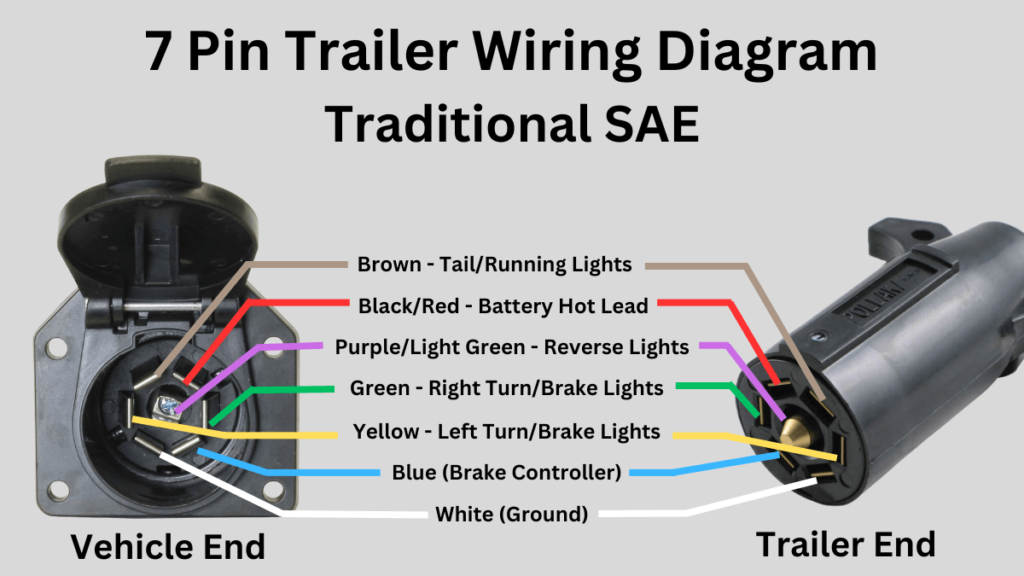
7 Pin Trailer Wiring Diagram – RV Standard
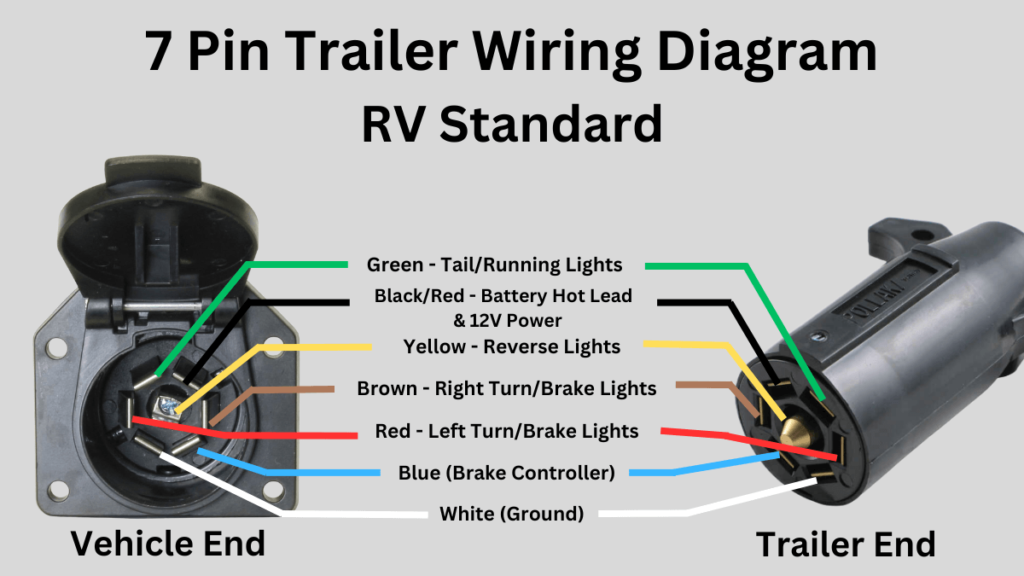
7 Pin Trailer Wiring Diagram – Heavy Duty
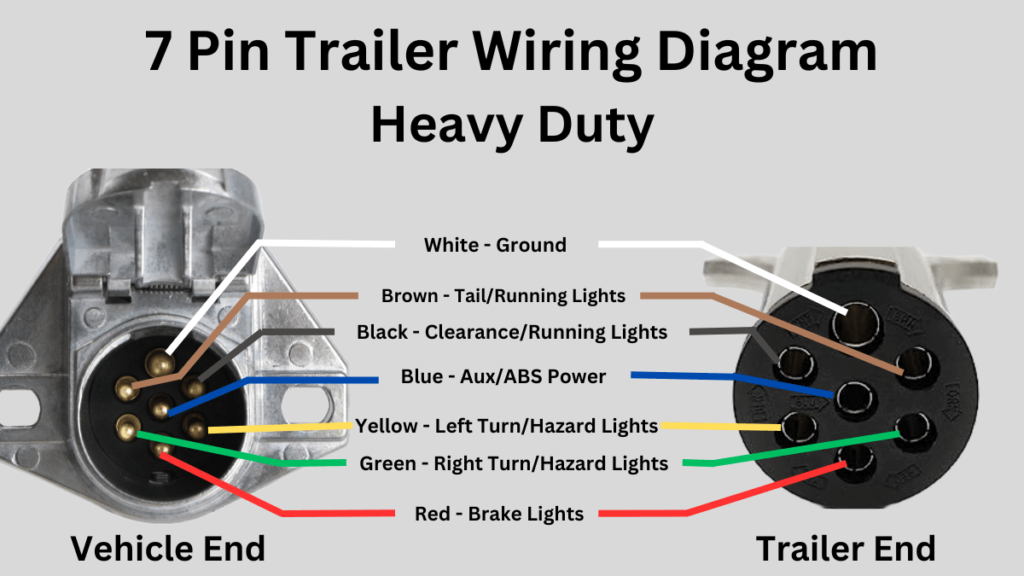
7 Pin Trailer Wiring
The 7 pin trailer connector is by far the most common trailer connector there is these days, and is universal with pretty much any make and model of vehicle.
If you’ve bought a trailer somewhat recently, there’s a very good chance it features this 7 pin connector plug.
To accommodate this, most modern vehicles that feature a trailer hitch also come equipped with a 7 way connector socket near the hitch where the trailer connector plugs in and syncs all the electrical components.
If you have an older trailer or vehicle, you may find that you have one of the following connectors rather than the standard 7 pin connection:
- Four-way wiring connection
- Five-way wiring connection
- Six-way wiring connection
If you find that you have one of these non-standard connectors on your vehicle or trailer but also a 7 pin connector on the other end, you’ll need to do one of two things:
- Use an adapter that can sync the two different types of connectors, which is the easiest option.
- Convert the non-standard connector to a 7 pin connector by replacing it, which is the more difficult option.
Before syncing your vehicle with your trailer, it’s important to know which type of trailer you’re using and the functions of each of the different colored wires on the trailer connectors which can be found above.
Three Main Types of Trailers
There are three main types of trailers, all with slightly different colored wiring and connectors.
- Traditional SAE
- RV Standard
Traditional SAE – this is going to be the most common trailer you’ll find and include utility trailers, equipment trailers, or cargo trailers.
If you’re pulling a boat, off-road vehicle, or hauling materials of some sort this will most likely be what you’re using to do so.
RV Standard – if you’re pulling an RV, this is likely going to be what you’re using.
Heavy Duty – these are going to be your commercial or agricultural trailers, used for tougher jobs and to carry very heavy loads.
If you’re using a flatbed trailer to tow construction materials (think lumber, steel, heavy machinery), a dump trailer (stones, gravel, soil), or car hauler trailers to tow one or multiple vehicles, this is likely what you’re using.
While each trailer type is similar in terms of their different wiring connections, there are some slight differences as well.
Confirming Your Wiring Configuration
If you suspect that your wiring configuration is not universal, or if some or all of the trailer functions don’t seem to be working when connected, you can confirm what each wire does with the help of a circuit tester.
If you don’t seem to be getting a signal from the wires when using a circuit tester, check the fuse box under the hood of your vehicle to ensure the necessary fuses for the towing connection are installed.
If you’re looking to sync a trailer with your Chevy truck , occasionally these fuses will not be installed from the factory and you’ll need to take care of it on your own for the trailer functions to properly sync.
It’s highly important when towing a trailer behind your vehicle that each function is working correctly to ensure safe travel.
While electrical work can be intimidating for those of all experience levels, this 7 pin trailer wiring diagram should make it easier on you.

Your guide for All things off-road.
Follow us on social!
© Offroad official 2024
.png)
FREE SHIPPING ON $150+ ORDERS
RV Trailer Wire Diagrams: How to Wire Your Trailer the Right Way
Learn how to wire your trailer so you can seamlessly use all electric appliances in your trailer as well as tow the trailer effectively.

Embarking on a road trip adventure in your RV is exciting, but don’t forget to make sure your RV’s systems are in order before hitting the road! One critical aspect often overlooked is the correct wiring of your recreational vehicle. A well-wired trailer not only promotes safety on the road but also ensures that your lights, brakes, and signals function seamlessly.
From powering appliances to maintaining essential safety systems, understanding the ins and outs of RV wiring is a must for any enthusiast. Whether you're a seasoned traveler or a novice hitting the open road, your RV’s electrical system is complex and requires attention. Lucky for you, we have covered everything you need to know and get in order before you set out. Take a read below so that you can navigate the process with confidence and enjoy a stress-free journey ahead!
The Importance of Proper RV Wiring
Proper RV wiring is more than just a technicality; it's the backbone of a safe and functional road trip experience. Without accurate and well-maintained wiring, you risk a host of problems that can quickly turn your adventure into a nightmare. Safety comes first, and correctly wired systems ensure that crucial functions like lights, brakes, and electrical appliances work seamlessly. This not only safeguards you and your fellow travel companions but also other motorists on the road. Other than that, efficient wiring maximizes energy usage, saving power and ultimately extending the lifespan of your RV's components.
Different Types of RV Trailers and Wiring Needs
The diverse world of RV trailers encompasses a wide range of options, each with unique wiring needs. When it comes to wiring requirements, travel trailers are a popular choice for those who prefer versatility and mobility. A typical travel trailer often utilizes a 30-amp RV 7-way trailer wiring diagram to handle essential systems like lighting, brakes , and appliances while smaller trailers operate with a 5-wire trailer connector and even a 2-wire trailer connector. These trailers are designed to be compact and lightweight, making them suitable for a 30-amp electrical supply.
On the other hand, fifth-wheel trailers cater to a more luxurious camping experience , requiring a robust 50-amp RV trailer plug wiring diagram to accommodate larger appliances, air conditioning units , and advanced entertainment systems. The substantial power requirements of these trailers make the 50-amp RV plug a vital component in ensuring all amenities function smoothly.
Additionally, the specific wiring requirements can vary based on the age and make of the RV trailer. Older models may require updates and renovations to bring their wiring systems up to modern safety and technology standards. Vintage Airstream trailers, for example, often need comprehensive overhauls to support modern conveniences. In contrast, newer RV trailers are typically equipped with advanced RV trailer wiring harnesses and the usual 2 trailer hitch ball mount, designed to handle high-tech devices and provide enhanced convenience.
Whether you're towing an older model or a brand-new luxury RV trailer, understanding the distinct wiring needs is crucial to ensure your trailer is not only functional but also optimized for the level of comfort and convenience you desire during your travels. So, considering the type of RV trailer and its age is vital in determining the wiring requirements, whether it's a 7 pin RV trailer wiring diagram, 4 wire trailer connector, or a 5 wire trailer wiring to 7 pin setup.
Basic Components of RV Trailer Wiring Systems
Before diving in, it is important to know just what you are dealing with. These components collectively form the backbone of an RV trailer's wiring system, whether you're dealing with a 30 amp RV wiring diagram or a 50 amp RV plug wiring diagram. Understanding these elements is essential for maintaining, troubleshooting, and ensuring the safe operation of your RV trailer during your travels. Give a quick read below to get a gist of the components in the system!
7-Way Connector:
The 7-way connector is a pivotal component that links the trailer's wiring to the tow vehicle. It consists of seven pins, each serving a specific purpose. These pins are numbered and color-coded for easy identification, ensuring the proper connection of power and signals between the RV trailer and the towing vehicle. One essential function of a 7-pin trailer plug is to charge the RV’s battery as it's being towed, ensuring that the trailer's electrical system remains operational.
Wiring Harness:
An RV trailer wiring harness is a network of cables and wires that extends throughout the RV trailer. It includes various wires for lighting, brakes, battery charging, and auxiliary power. This harness ensures a systematic and organized distribution of electricity from the 7-way connector to the trailer's components.
Trailer Wire Adaptor Connector:
A trailer wire adapter connector is a necessary component for the RV trailer wiring system as it helps to bridge the gap between different towing vehicles and trailers. This device ensures compatibility between various 2-wire trailer connectors and the towing vehicle's wiring.
Hitch Ball:
The hitch ball is crucial because it's the direct point of connection between the tow vehicle and the RV trailer. It ensures a secure link, allowing the trailer to be towed safely and effectively. Selecting the correct ball size for trailers is imperative, even for gooseneck trailers for safe towing as an incorrect size can lead to an unstable connection and potential accidents on the road.
Ball Mount:
A 2-trailer hitch ball mount plays a vital role in maintaining the level of the trailer when attached to the tow vehicle. Proper leveling is essential for safe towing because it ensures that the trailer's weight is distributed evenly, preventing issues like swaying or excessive strain on the tow vehicle's suspension.
Auxiliary Power Circuit:
The auxiliary power circuit in the 7-way connector is a versatile feature. It allows the trailer to draw power from the tow vehicle for various purposes, such as running interior appliances or charging auxiliary batteries. This added flexibility ensures that the trailer can meet a range of power requirements.
Ground Wire:
A ground wire is a fundamental part of the RV trailer wiring system. It connects to the metal frame of the trailer, creating a secure ground path for the electrical system. Proper grounding minimizes the risk of electrical issues, ensuring that the various components and systems function reliably and safely.
A Guide to Wiring Your Trailer the Right Way
With so many components and wires to keep track of, you won’t be the only person who gets confused. Follow our step-by-step guide below to make better sense of the process. By understanding the specific wiring needs of your trailer, you can wire your trailer correctly, whether it's a 5-wire trailer wiring to 7-pin setup or any other configuration. Here's a 10-step guide you on how to wire a 7-pin trailer plug the right way:
Step 1: Gather Tools and Materials
Ensure you have all the necessary tools, including wire cutters, crimping tools, heat shrink tubing, and materials like the appropriate gauge wire, a 5-pin trailer plug or a 5-pin to 7-pin trailer plug, and other trailer hitch ball accessories.
Step 2: Determine Wiring Needs
Understand your trailer's wiring needs based on its type and size. This could involve a travel trailer with a 30 amp RV wiring diagram or a travel trailer with a 50 amp RV plug wiring diagram, depending on the trailer's electrical demands.
Step 3: Locate the 7-Way Connector
Identify the ideal location on your trailer for mounting the 7-way connector. This should be easily accessible and near the rear for connection to the tow vehicle.
Step 4: Prepare the Wires
Trim and strip the wire ends for clean connections. Ensure you use the correct wire colors based on standard coding: red (12V power), green (right turn/brake), yellow (left turn/brake), white (ground), and so on.
Step 5: Connect the Wires
Connect the stripped wires to their respective pins on the 7-pin trailer plug. Use crimp connectors for a secure connection, ensuring a snug fit and good conductivity.
Step 6: Protect the Connections
Slide heat shrink tubing over the crimped connections and apply heat to seal and protect the wires from moisture and corrosion. Ensure a watertight seal.
Step 7: Secure the Wiring
Use zip ties or clamps to secure the wiring along the trailer frame. Prevent loose wires that could be damaged or drag on the road.
Step 8: Ground Wire Installation
Attach the white wire, which is the ground wire, securely to the trailer frame. Ensure a clean and rust-free connection point.
Step 9: Test the Wiring
Before hitting the road, test all the connections. Verify that all lights, turn signals, brakes, and other electrical components work correctly. A trailer wire adapter connector can be helpful for compatibility with your tow vehicle's wiring.
Step 10: Secure the 7-Way Connector
Mount the 7-way connector securely in its designated location on the trailer. Ensure it is protected from the elements and won't become disconnected during travel.
RV Trailer Wiring Diagrams
Here are some common trailer wiring diagrams for your reference.
RV 7 Way Trailer Wiring Diagram

4 Wire Trailer Connector Diagram

RV 7 to 6 Trailer Wiring Diagram

RV 7 to 5 Trailer Wiring Diagram

RV 7 to 4 Trailer Wiring Diagram

RV 4 to 4 Trailer Wiring Diagram

Common Mistakes to Avoid in Trailer Wiring
If you are new to understanding the wiring system of your RV, you are bound to make some mistakes. Ensuring proper trailer wiring is essential for safe and trouble-free towing. To help you avoid common mistakes, here are five pitfalls to steer clear of when working on your trailer's electrical system:
Inadequate Grounding:
A frequent mistake in trailer wiring is neglecting the importance of proper grounding. Failing to establish a solid ground connection between the trailer's wiring and the frame can lead to erratic electrical behavior. Ensure that the white wire (ground) is securely attached to a clean, rust-free part of the trailer frame, providing a reliable path for the current to return to the battery.
Incorrect Wire Sizing:
Using the wrong gauge of wire is another common error. The wire size should match the electrical load and distance it needs to travel as an inadequate wire gauge can lead to voltage drop and insufficient power to your trailer's components. To know what size wire you need for the trailer wiring systems, check the manufacturer's recommendations or refer to the RV wiring diagram.
Neglecting Weatherproofing:
Failing to protect your connections and wiring from the elements is a recipe for trouble. Exposed wires and connections can quickly corrode or short-circuit when exposed to moisture. Use heat shrink tubing or electrical tape to seal and protect your connections, ensuring they remain dry and corrosion-free.
Poor Cable Management:
Untidy and loosely secured wiring is not just unsightly; it can also be dangerous. Wires that dangle or drag on the road can get damaged or pose a safety hazard. Use zip ties or cable clamps to secure the wiring along the trailer frame, keeping it away from moving parts and road debris.
Incorrect Wiring Order:
Reversing the wiring order or improperly connecting the wires to the trailer plug is a common mistake. This can result in erratic lighting, non-functional brakes, or even electrical damage to your tow vehicle. Always consult a 7-pin RV trailer wiring diagram or the manufacturer's guidelines to ensure the proper connection of wires to the trailer plug.
Safety Tips to Keep in Mind When Wiring Your Trailer
Remember, at the end of the day, you are dealing with electrical wires and a complicated system. It is prone to accidents, sparks, unseen issues, and a multitude of other problems. By following these 5 safety tips when wiring a trailer, you can significantly reduce the risk of accidents.
Disconnect Power Sources:
Before starting any wiring work, ensure that all power sources are disconnected. This includes unplugging the tow vehicle, disconnecting the trailer from the vehicle, and disconnecting any batteries that may be part of the trailer's electrical system. This precaution eliminates the risk of electrical shock or short circuits during the installation or repair process.
Eye Protection and Gloves:
Wearing appropriate personal protective equipment is crucial. Safety glasses or goggles can protect your eyes from potential debris and wire ends. Additionally, insulated gloves are essential to minimize the risk of electrical shock while working with wires and connections.
Work in a Dry Environment:
Wiring tasks should be performed in a dry environment. Moisture and wet conditions can lead to electrical hazards, so it's essential to avoid working on your trailer's wiring during rainy weather. If you must work in damp conditions, take extra precautions to keep all connections dry and use waterproof sealants.
Use the Right Tools and Materials:
Using the proper tools and materials is essential for safety. Make sure your wire cutters, crimping tools, and connectors are in good condition and appropriate for the job. When making connections, use heat shrink tubing or electrical tape to insulate and protect the wires, and choose high-quality components and materials to ensure a reliable and safe trailer wiring system. Also make sure to learn beforehand what size wire you need for the trailer wiring and what size ball you need for your trailer, especially for a gooseneck trailer, so that you don’t encounter these issues after you start wiring your trailer.
Double-Check Your Work:
After completing the wiring, it's crucial to double-check your work for any loose connections, exposed wires, or potential issues. Test all the trailer's lights, brakes, and signals to ensure they function correctly. It's better to identify and rectify any issues before hitting the road, reducing the risk of accidents or breakdowns during your journey.
In the world of RV traveling, trailer wiring and safety are paramount. Your guide to a comfortable journey begins with ensuring a solid, secure electrical foundation. With proper grounding, the right tools, and a vigilant eye for detail, you're on your way to a world of comfort and adventures.
- How To's
Recent Posts
10 Travel Trailer Renovation Tips on a Budget
Backing Up a Trailer: A Guide
Mounting a TV in an RV: All You Need to Know
DISCLAIMER: Some links in our blog posts may be affiliate or paid links. We may earn a commission if you click on these links and make a purchase. Your support through these links helps keep our blog running. Thank you!
Trailer Wiring Diagram: A Complete Tutorial
If you recently bought a trailer or finally decided to connect your already present one to your pickup. We have all your concerns covered in this article on the different types of wirings used and how to get your trailer connected with your car perfectly.
What is a Trailer?
A trailer is an unpowered vehicle and is supposed to be towed by another vehicle: SUVs, pickup trucks, or jeeps commonly tow trailers. They can also be recreational vehicles depending on their type.
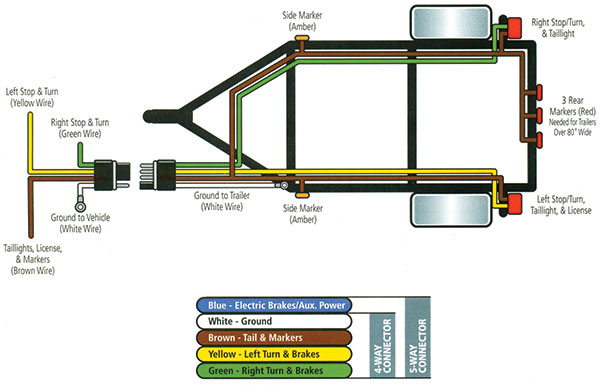
How Does a Trailer Work?
A trailer is a separate extension vehicle that needs to be linked with the primary vehicle. The trailer is attached to the primary vehicle by the appropriate hitch. To make the trailer’s electric output work, we use different connectors to ensure that depending on the outputs we require. The minimum output connector is the 4-Way connector, providing electrical output to the trailer's signals and ground and tail lights.
The Applications of Trailers
The trailer has several applications depending on the user and what kind of services one might be looking for. They are used for transporting goods, materials, boats, camping utilities, etc. The different types of trailers are as follows:
- Utility Trailer
- Travel Trailer
- Boat Trailer
- Semi-Trailer
- Construction Trailer
- Gooseneck Trailer
- 5th Wheel Trailer
Want to Draw Wiring Diagram with Standard Symbols? Try This Out!
EdrawMax Wiring Diagram Software creates professional wiring diagram for free with easy-to-edit templates and symbols. Give it a try!
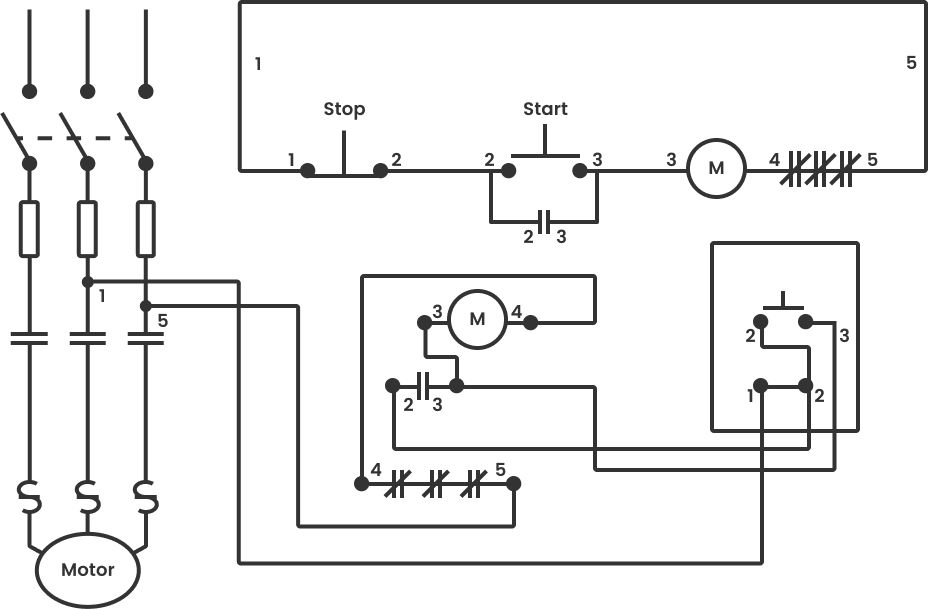
What is the Color Code for Trailer Wiring?
The most daunting task in regards to a trailer would be connecting it with your primary vehicle. If you are worried about how you can achieve this, color codes have got you covered. The trailer wiring has different colors that make it easy to understand and link up the wires with the primary vehicle and the connector.
What are the Trailer Wire Color Codes?
Trailer wiring has different color codes assigned for each wire to make it easier to connect the wires. To understand the color codes better, here is a comprehensive chart.
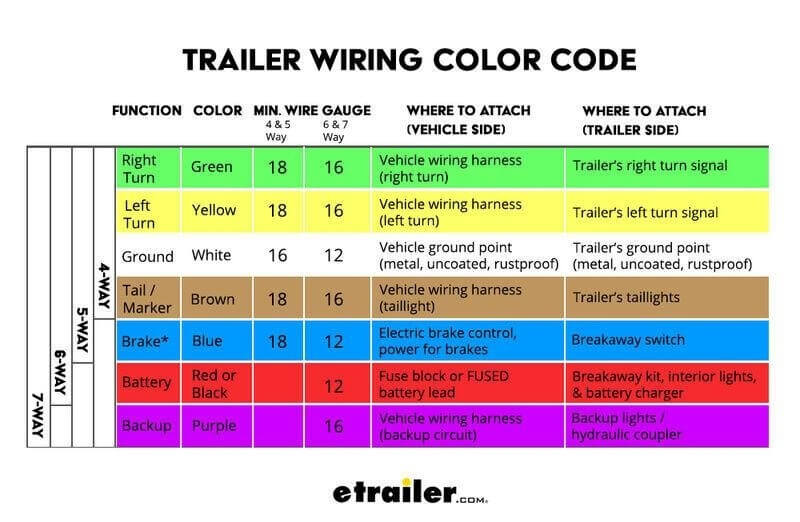
This chart shows what each color code stands for, which makes it very easy to coordinate which wire goes where.
Trailer Wiring Diagram [4-Pin, 5-Pin, 6-Pin, 7-Pin]
4-pin trailer wiring diagram.
As you can observe from this 4-pin trailer wiring diagram , the white wire is connected to the ground. The green runs at the back to connect with the right turn. The brown wire, which is responsible for handling the taillights, leads to both the light bulbs at the back, and the yellow wire runs back to the left to indicate a left turn. They are all connected by a 4-way connector.
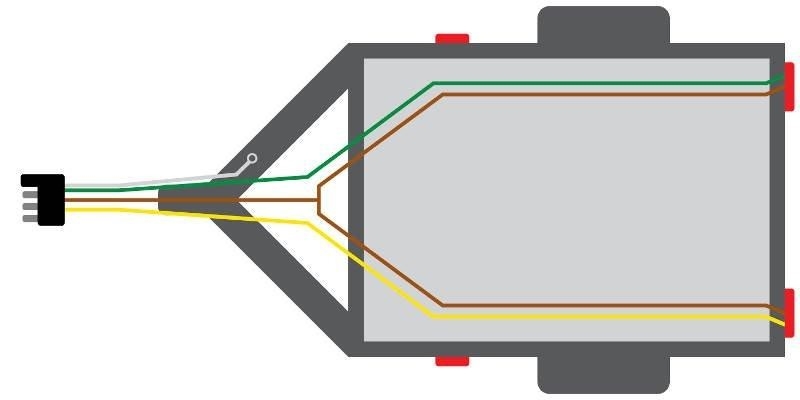
*What is the 4-Way Connector?
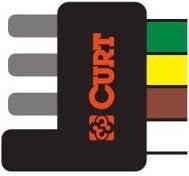
4-Way connectors are the most basic connectors used for hooking up your trailer with the primary vehicle. The 4-Way connector allows you to control the three essential light functions: the break, right turn, and left turn. The fourth wire (White), as shown in the diagram, is the ground wire. Usually, light-duty trailers use this connector.
5-Pin Trailer Wiring Diagram
In this 5-pin trailer wiring diagram above, you can see that the first wire is the ground wire (white). The second wire (green) to originate from the connector is responsible for the right signal. The third (brown) wire is the one that is responsible for the taillights. These are also connected to the side to ensure increased visibility.
The fourth wire (blue) is the one that indicates when the brakes are applied. The last set of wires (yellow) leads to the left side to indicate the left signal. These are connected via the 5-Way connector.
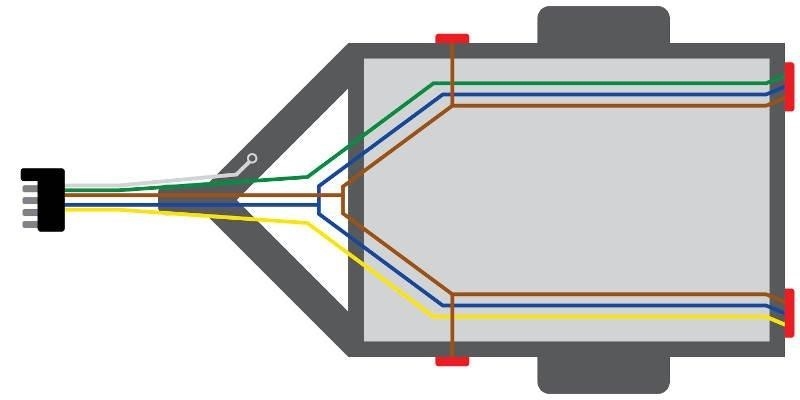
*What is the 5-Way Connector?
A 5-way connector is used to establish an electrical connection between the trailer and the primary vehicle. It is usually used by vehicles that use hydraulic or surge brakes. One pin is used for grounding; the other commonly used are for indicating turns, breaks, and that the car is running.
The extra wire is connected with the backup lights that help disengage the hydraulic coupler of the trailer when the vehicle starts to reverse; this turns off the brakes of the trailer. So this wire also serves as the reverse light.
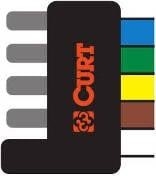
Outstand Wiring Diagram Software >>
6-pin trailer wiring diagram.

In this 6-pin trailer wiring diagram , as it can be observed, there are two new wire positionings. The blue wire responsible for the hydraulic brakes is now used for electric brakes. The black wire is an indicator for the +12v battery attached to the trailer—the other wires are in the same fashion as the previous trailer diagrams.
*What is the 6-Way Connector?
The 6-way connector helps establish a connection between the primary vehicle and the trailer. It is used for brake control (mainly electric brakes) and are commonly used on campers, gooseneck trailers, and horse trailers.
This connector provides additional electrical support for a 12-volt battery via the black wire and electrical breaks via the blue wire.

7-Pin Trailer Wiring Diagram
The 7-pin trailer diagram has three different variations depending on the type of connector in which the wiring configuration is also different. These different 7-pin trailer wiring diagrams are as follows.
*7-Pin Trailer Wiring Diagram with a Round Prong
In this 7-pin trailer wiring diagram, the red wire provides auxiliary power to the trailer while the black wires are shifted to indicate the reverse lights. The other wire functionalities and placements are similar to those in a 6-pin trailer diagram where white is for ground, green is for right, yellow is for left, brown is for tail lights, and blue is for electric brakes.
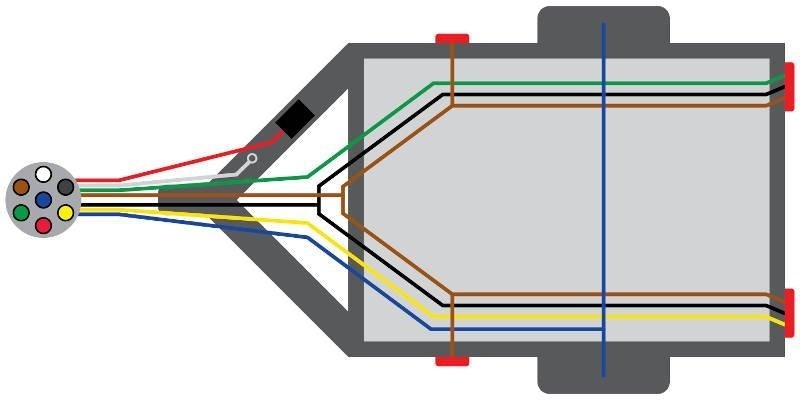
*7-Pin Trailer Diagram for RV Blade with SAE Configuration
This 7-pin trailer wiring diagram shows that the colors of the wires have been changed for the reverse lights and battery source. The red color has been changed to orange and black to grey. The other colors remain the same for the other wires and their functionality as well.
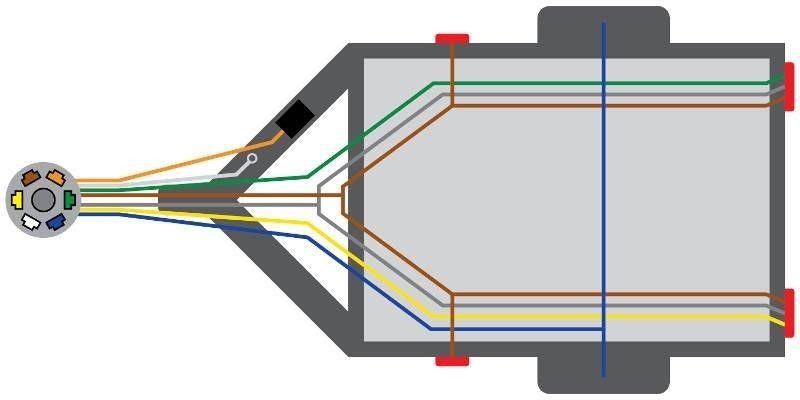
*7-Pin Trailer Diagram for Traditional RV Blade
In this 7-pin trailer wiring diagram, most of the wire configuration is changed. The brown wire connects with the right light. The green wire connects with the taillights, the yellow wire connects with the reverse lights, and the red wire connects with the left light.
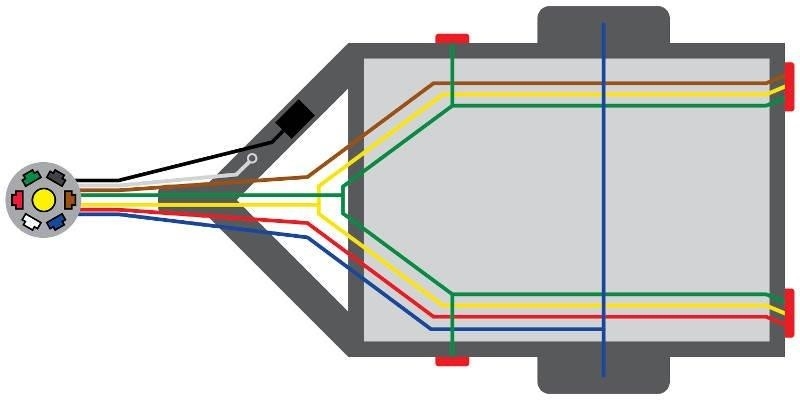
While the black wire connects with the battery, the blue wire connects with the electric brakes, and the white wire is connected with the ground. Connecting these in the correct order will ensure that the trailer lights work perfectly in sync with your primary vehicles.
*What is the 7-Way Connector?
The connector helps you connect the wiring of your primary vehicle with that of your trailer. These are usually used for large campers, SUVs, trucks, commercial and agriculture trailers. Above are the three different connectors used for the wiring of a 7-pin trailer light system.
It is necessary to know the proper configuration of your trailer so that you can wire it ideally and your trailer lights work in sync.
Use EdrawMax for Wiring Diagram Creation
We would recommend that you use EdrawMax Wiring Diagram Software for making trailer wiring diagrams . There are several templates that you can use to make the perfect trailer wiring diagram after seeing the configuration of your car.

IMAGES
VIDEO
COMMENTS
There are 2 conflicting 12v standards. Marine and automotive use red = +, black = - (ground). RV is an offshoot from house AC. Black = +, white = - (ground). Any pre-wired marine or car accessory will have black and red wires coming out of it. FR "electricians" will use RV wiring to complete the circuit (usually).
Trailer Wire Color Codes - Colors Coordinate With Trailer Wiring Diagram; Connector Style Pin Function Color Description; 7-Pin: 6-Pin: 5-Pin: 4-Pin: 1: ... The Brown Wire goes to the lights that are always ON as you travel. These are the running lights, the low intensity portion of the tail lights, side markers, and corner markers. Also, if ...
This trailer wiring guide comes complete with a color coded trailer wiring diagram for each plug type, including a 7 pin trailer wiring diagram, this guide walks through various trailer wiring installation solution, including custom wiring, splice-in wiring and replacement wiring. If your vehicle is not equipped with a working trailer wiring harness, there are a number of different solutions ...
Learn how Keystone's EXCLUSIVE color-coded 12V wiring is different from conventional RV wiring and why it's a better for both owners and service technicians. Easy-to-trace circuits help dealer service techs troubleshoot and complete repairs more quickly, saving owner's time and money. Clearly labeled wiring helps savvy owners with DIY ...
Other colors in the RV wiring color code include red, blue, yellow, and green. These colors are usually associated with specific functions, such as brake lights, turn signals, running lights, and ground connections. Following the RV wiring color code ensures that the electrical system in an RV is properly installed and functions safely and ...
Choose the Right Trailer Wire Gauge. Standard trailer wire gauges usually range from 18 to 12, with 12 gauge being the thickest. Trailer size, power, the number of functions, and the loads the trailer will carry can all affect trailer wire gauge; larger trailers with heavier loads should opt for heavy-duty trailer cable for reliability and safety, like 14 gauge or 12 gauge.
Trailer Wiring Connectors. Various connectors are available from four to seven pins that allow for the transfer of power for the lighting as well as auxiliary functions such as an electric trailer brake controller, backup lights, or a 12V power supply for a winch or interior trailer lights. Choose a connector that has the required number of ...
is typically used on 5th wheel trailers, travel trailers and campers. SAE J2863 configuration The SAE J2863 7-way RV blade format is typically used on gooseneck trailers, utility trailers, cargo trailers and equipment trailers. 6-Way Square Vehicle side Function +12 volt Electric brakes Reverse lights Left turn / brakes Right turn / brakes
These four colored wires make up your trailer's wiring system. Each connects to a different function: Brown wire to the tail or parking lights. Green wire to right turn signal/brake light. Yellow wire to the left turn signal/brake light. White wire to common or chassis ground. When making your repairs or hooking up your trailer, you simply make ...
6 Pin Trailer Wiring. For heavier towing jobs, many use gooseneck trailers. Those are generally put in the bed of a truck and use a 6-pin trailer wiring adapter. 6-Pin trailer wiring uses the same color code as 4- and 5-pin trailer wiring, adding one more function. This wire is black and adds auxiliary power. Most 6-pin wiring is rounded. 6 Pin ...
It may not apply to our Palomino. Q: Is there a standard wiring color code for travel trailers? There are 2 conflicting 12v standards. Marine and automotive use red = +, black = - (ground). RV is an offshoot from house AC. Black = +, white = - (ground). Any pre-wired marine or car accessory will have black and red wires coming out of it.
7 Pin Trailer Wiring - Color Codes. There are seven different electrical wires that connect and sync the 7 pin trailer connector with your vehicle. ... s highly important when towing a trailer behind your vehicle that each function is working correctly to ensure safe travel. While electrical work can be intimidating for those of all ...
The minimum suggested wire size for a 7-way trailer plug is 16 gauge for the turn signals, brake lights, reverse lights, and running light wires. The suggested minimum for the ground, brake power, and battery hot lead wires is 12 gauge. If the wire is too thin, it can overheat and even catch fire when carrying electrical current.
The color code for trailer wiring varies slightly depending on the country or region, but there are some common color standards used across the industry. The most widely recognized color code for trailer wiring includes the following colors: white, brown, green, yellow, blue, and red. Each color corresponds to a specific function, such as ...
A good place to start is by getting to know the industry-standard color codes for trailer wires. Green is for the right turn signal. Yellow is for left turn signal. White is ground, and brown is for the trailer's taillights. These four types of wires together constitute what is known as "four-way wiring.". Four-way wiring is quite common ...
#KeystoneRVFor more information visit: https://www.keystonerv.com/About Keystone: The #1 manufacturer of fifth wheel camping trailers and the third largest m...
These pins are numbered and color-coded for easy identification, ensuring the proper connection of power and signals between the RV trailer and the towing vehicle. ... This could involve a travel trailer with a 30 amp RV wiring diagram or a travel trailer with a 50 amp RV plug wiring diagram, depending on the trailer's electrical demands. Step ...
Yellow wire - Left stop and turn. Green wire - Right stop and turn. Brown wire - Tail lights, rear marker lights, front and rear side lights. White wire - Ground. State and Federal regulations require all types of trailers to be equipped with tail, stop, turn and side marker lights. Trailers over 80 inches wide must have clearance and ...
The trailer wiring has different colors that make it easy to understand and link up the wires with the primary vehicle and the connector. What are the Trailer Wire Color Codes? Trailer wiring has different color codes assigned for each wire to make it easier to connect the wires. To understand the color codes better, here is a comprehensive chart.
It's called NFPA 1192, which you can read here. And there's something similar for campground wiring called NFPA 1194, which you can read here. The RVIA (Recreational Vehicle Industry Association) requires that all manufacturers displaying the RVIA tag comply with NFPA 1192, which is basically electrical code for RVs.
RVs typically use AC and DC power to run the entire electrical system. DC (direct current) power flows one way. If you power electronics using your RV's battery, you'll use DC power. RVs use these DC 12V systems for lights, fans, and even USB ports. The other type of power, AC (alternating current), flows in different directions.
The colors for wiring a 7-way connector are as follows with the 4 colors of the 4-way connector remaining the same. White-Ground. Brown-Tail/Running Lights. Green-Right Turn/Brake - Remember green has an R in it. Yellow-Left Turn/Brake - Remember yellow has an L in it. Blue-Brake Controller Output.
With stranded 12V wiring on RV's, the white is ground and the tracer color is positive. Keystone uses a standardized color code: 2012 Copper Canyon 273FWRET being towed by a 1994 Ford F350 CC,LB,Dually diesel. Airlift 5000 bags, Prodigy brake control, 5 gauges on the pillar.Used to tow a '97 Jayco 323RKS.